Paul van Yperen's Blog, page 311
April 23, 2017
Exported to the USA: Ann-Margret
Ann-Margret (1941) is a Swedish-American actress, singer and dancer, with a career that spans five decades. Her trademarks are her breathless voice, strawberry blonde hair and voluptuous figure which lead to the nickname 'sex kitten'.
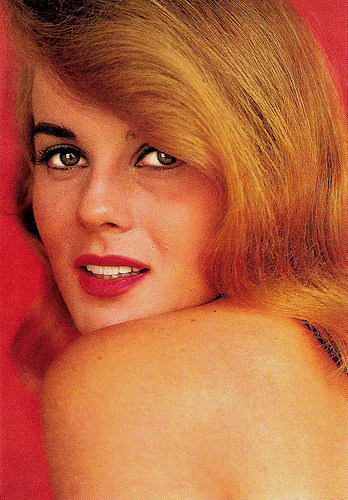
Spanish postcard by Postal Oscarcolor, S.L., no. 336.
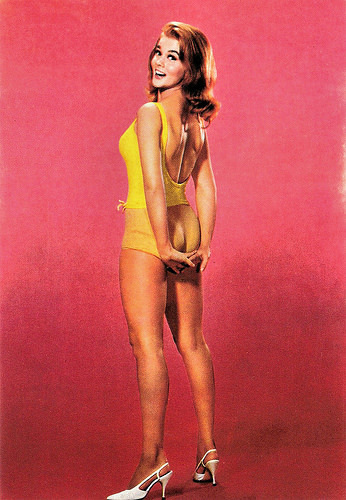
Italian postcard. Photo: Metro-Goldwyn-Mayer. Publicity still for Made in Paris (Boris Sagal, 1966).
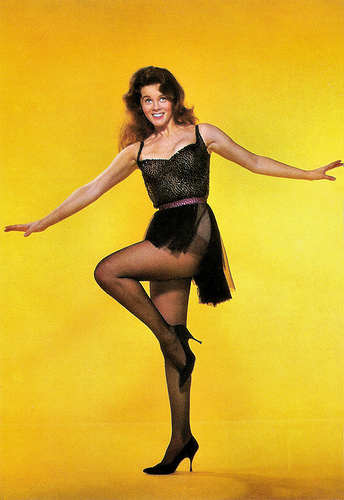
Spanish postcard by Postal Oscarcolor, no. 018-65.
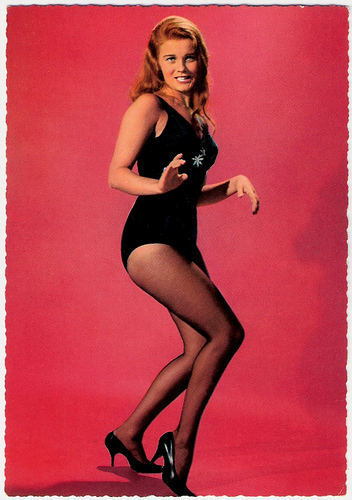
German postcard by Krüger, no. 902/250.
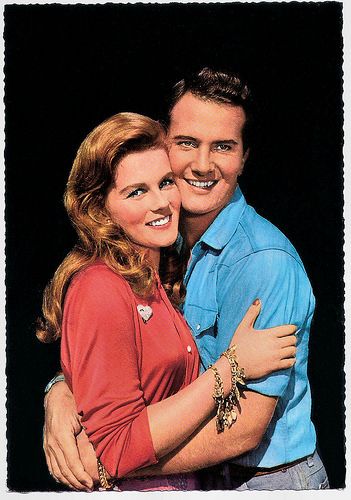
German postcard by Krüger, no. 902/263. Photo: publicity still for State Fair (José Ferrer, 1962) with Pat Boone.
Born in Sweden
Ann-Margret Olsson was born in Valsjöbyn, Jämtland County, Sweden in 1941. Her parents were Anna Regina (Aronsson) and Carl Gustav Olsson. Her father worked in the United States during his youth and moved there again in 1942, working with the Johnson Electrical Company, while his wife and daughter stayed behind.
Mother and daughter came to America in 1946. Her father took his daughter to Radio City Music Hall on the day they arrived. They settled just outside Chicago, in Wilmette, Illinois. She became a naturalised citizen of the United States in 1949 and took her first dance lessons at the Marjorie Young School of Dance. While she attended New Trier High School in Winnetka, Illinois, she starred in theatricals.
As part of a group known as the Suttletones, she performed at the Mist, a Chicago nightclub. The group finally arrived at the Dunes in Las Vegas. There, Ann-Margret was discovered by George Burns and soon afterwards got both a record deal at RCA. In 1961, her single I Just Don't Understand charted in the Top 20 of the Billboard Hot 100.
That same year, Ann-Margret filmed a screen test at 20th Century Fox and was signed to a seven-year contract. She made her film debut in Pocketful of Miracles (1961), with Bette Davis. It was a remake of Lady for a Day (1933). Both versions were directed by Frank Capra. Then came a remake of Rodgers and Hammerstein's musical State Fair (José Ferrer, 1962), playing the 'bad girl' role of Emily opposite Bobby Darin and Pat Boone. It was considered to be a financially and critically flop.
Her next starring role, as the all-American teenager Kim from Sweet Apple, Ohio, in Bye Bye Birdie (George Sidney, 1963), made her a major star. She became a teen idol with her role in Viva Las Vegas (George Sidney, 1964) with Elvis Presley. While working on the film Once a Thief (Ralph Nelson, 1965), with Alain Delon , she met future husband Roger Smith, known for his starring role in the private-eye television series 77 Sunset Strip.
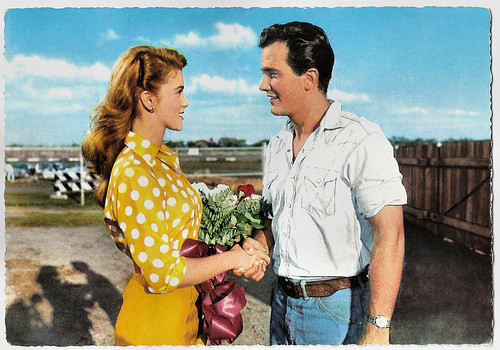
German postcard by Krüger, no. 902/262. Photo: publicity still for State Fair (José Ferrer, 1962) with Pat Boone.
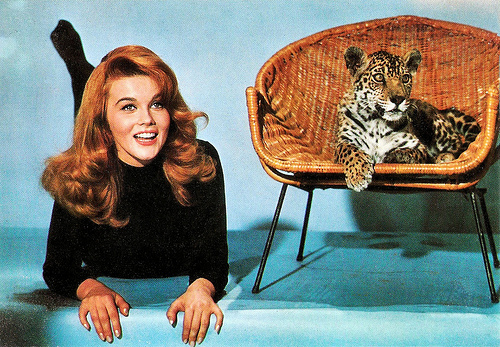
Spanish postcard by Postal Oscarcolor, S.L., no. 27. Photo: Universal Pictures. Publicity still for Kitten with a Whip (Douglas Heyes, 1964).
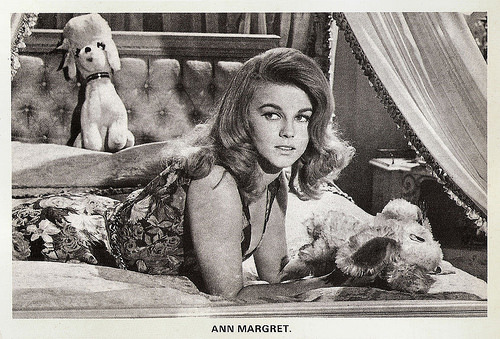
Spanish postcard by Productos Compactos, S.A., no. B 3789-1991. Photo: publicity still for Bus Riley's Back in Town (Harvey Hart, 1965).
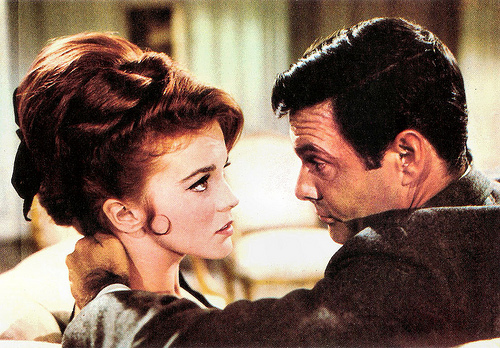
Italian postcard. Photo: Metro Goldwyn Mayer. Publicity still for Made in Paris (Boris Sagal, 1966) with Louis Jourdan .
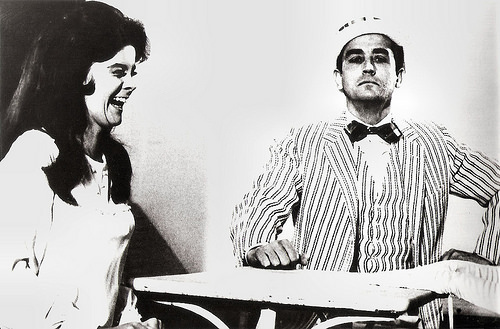
Romanian postcard by Casa Filmului Acin, no. 369. Photo: publicity still for Il Profeta/The Prophet (Dino Risi, 1968) with Vittorio Gassman .
Object of desire
As an actress, Ann-Margret is now best known for her roles in The Cincinnati Kid (Norman Jewison, 1965) opposite Steve McQueen, Carnal Knowledge (Mike Nichols, 1971) , and Tommy (Ken Russell, 1975), the rock opera film of the British rock band The Who. For her part of the over-loving girlfriend of a viciously abusive Jack Nicholson in Carnal Knowledge, she garnered an Oscar nomination for Best Supporting Actress, and for Tommy she was nominated for the Academy Award for Best Actress and won the Golden Globe Award.
During a lull in her film career in July 1967, Ann-Margret gave her first live performance in Las Vegas, with her husband Roger Smith (whom she had married in 1967) taking over as her manager after that engagement. For new film projects, she turned to Italy. Her Italian films are the comedy-drama Il tigre (Dino Risi, 1967) with Vittorio Gassman , Il profeta/The Prophet (Dino Risi, 1968), and the crime-comedy 7 uomini e un cervello/Criminal Affair (Rossano Brazzi, 1968) with Rossano Brazzi.
In 1972, she survived a dramatic 22-foot fall from a stage in a Lake Tahoe, Nevada concert. She broke an arm, suffered five fractures of five facial bones including a smashed cheekbone, and a brain concussion. 10 weeks later to the day, she was back on stage in Las Vegas. In 1979, she scored a disco hit with Love Rush. Later, she recorded the critically acclaimed gospel album God Is Love: The Gospel Sessions (2001), and an album of Christmas songs, Ann-Margret's Christmas Carol Collection (2004).
In 1982, she co-starred with Walter Matthau in the film version of Neil Simon's play I Ought to Be in Pictures, appeared with a six-year-old Angelina Jolie in Lookin' to Get Out, and played with Alan Bates , Glenda Jackson , and Julie Christie in The Return of the Soldier. On television, she starred in the TV movies Who Will Love My Children? (1983) and a remake of A Streetcar Named Desire (1984).
Other films include the crime thriller 52 Pick-Up (1986), as the wife of Roy Scheider's character. In 1991, she starred in the groundbreaking Our Sons (John Erman, 1991) opposite Julie Andrews as mothers of sons who are lovers, one of whom is dying of AIDS. A late career highlight for her was the hit comedy Grumpy Old Men (Donald Petrie, 1993) as the object of desire for Jack Lemmon and Walter Matthau.
Ann-Margret published an autobiography in 1994 titled Ann-Margret: My Story, in which she publicly acknowledged her battle with and ongoing recovery from alcoholism. In Any Given Sunday (Oliver Stone, 1999), she portrayed the mother of football team owner Cameron Diaz. In 2006, she had supporting roles in the box-office hits The Break-Up (Peyton Reed, 2006) with Jennifer Aniston and Vince Vaughn, and The Santa Clause 3 (Michael Lembeck, 2006) with Tim Allen.
In 2010, Ann-Margret won her first Emmy Award for her guest appearance on Law & Order: Special Victims Unit (2010). In total, she has won five Golden Globe Awards and been nominated for two Academy Awards, two Grammy Awards, a Screen Actors Guild Award, and six Emmy Awards. Her latest film is the upcoming American heist comedy Going in Style (Zach Braff, 2017) with Morgan Freeman, Michael Caine and Alan Arkin.
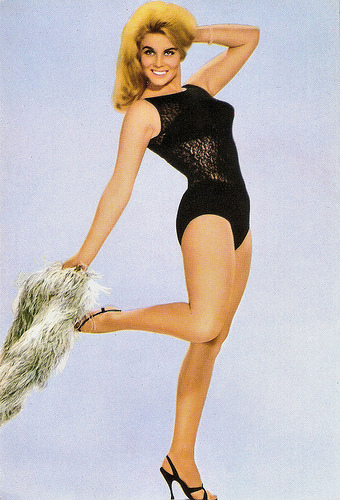
Spanish postcard, no. 100/118.
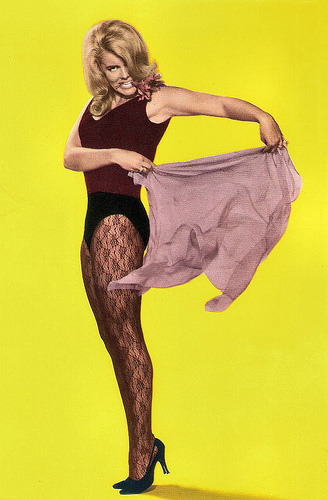
Spanish postcard by Ediciones Estes, no. 90-T. Photo: publicity still for Bye Bye Birdie (George Sidney, 1963).
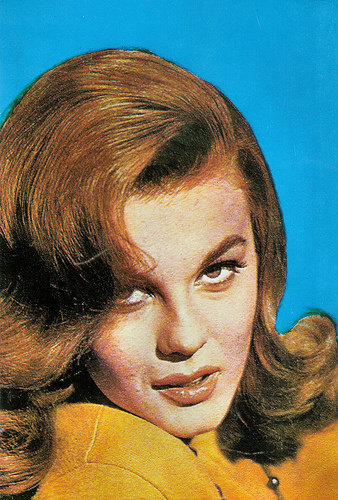
Romanian postcard by Casa Filmului Acin, no. 192.
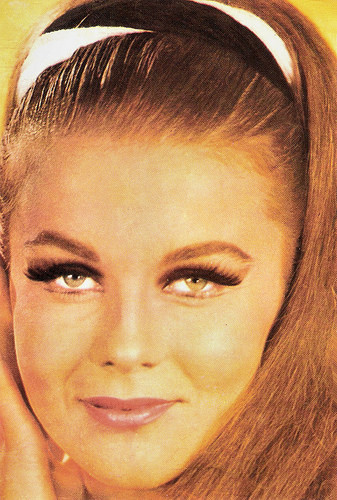
Romanian postcard by Casa Filmului Acin.
Romanian postcard by Casa Filmului Acin, no. 43 072. Photo: publicity still for the TV-movie A Streetcar Named Desire (John Erman, 1984) with Treat Williams.
Source: Wikipedia and .

Spanish postcard by Postal Oscarcolor, S.L., no. 336.

Italian postcard. Photo: Metro-Goldwyn-Mayer. Publicity still for Made in Paris (Boris Sagal, 1966).

Spanish postcard by Postal Oscarcolor, no. 018-65.

German postcard by Krüger, no. 902/250.

German postcard by Krüger, no. 902/263. Photo: publicity still for State Fair (José Ferrer, 1962) with Pat Boone.
Born in Sweden
Ann-Margret Olsson was born in Valsjöbyn, Jämtland County, Sweden in 1941. Her parents were Anna Regina (Aronsson) and Carl Gustav Olsson. Her father worked in the United States during his youth and moved there again in 1942, working with the Johnson Electrical Company, while his wife and daughter stayed behind.
Mother and daughter came to America in 1946. Her father took his daughter to Radio City Music Hall on the day they arrived. They settled just outside Chicago, in Wilmette, Illinois. She became a naturalised citizen of the United States in 1949 and took her first dance lessons at the Marjorie Young School of Dance. While she attended New Trier High School in Winnetka, Illinois, she starred in theatricals.
As part of a group known as the Suttletones, she performed at the Mist, a Chicago nightclub. The group finally arrived at the Dunes in Las Vegas. There, Ann-Margret was discovered by George Burns and soon afterwards got both a record deal at RCA. In 1961, her single I Just Don't Understand charted in the Top 20 of the Billboard Hot 100.
That same year, Ann-Margret filmed a screen test at 20th Century Fox and was signed to a seven-year contract. She made her film debut in Pocketful of Miracles (1961), with Bette Davis. It was a remake of Lady for a Day (1933). Both versions were directed by Frank Capra. Then came a remake of Rodgers and Hammerstein's musical State Fair (José Ferrer, 1962), playing the 'bad girl' role of Emily opposite Bobby Darin and Pat Boone. It was considered to be a financially and critically flop.
Her next starring role, as the all-American teenager Kim from Sweet Apple, Ohio, in Bye Bye Birdie (George Sidney, 1963), made her a major star. She became a teen idol with her role in Viva Las Vegas (George Sidney, 1964) with Elvis Presley. While working on the film Once a Thief (Ralph Nelson, 1965), with Alain Delon , she met future husband Roger Smith, known for his starring role in the private-eye television series 77 Sunset Strip.

German postcard by Krüger, no. 902/262. Photo: publicity still for State Fair (José Ferrer, 1962) with Pat Boone.

Spanish postcard by Postal Oscarcolor, S.L., no. 27. Photo: Universal Pictures. Publicity still for Kitten with a Whip (Douglas Heyes, 1964).

Spanish postcard by Productos Compactos, S.A., no. B 3789-1991. Photo: publicity still for Bus Riley's Back in Town (Harvey Hart, 1965).

Italian postcard. Photo: Metro Goldwyn Mayer. Publicity still for Made in Paris (Boris Sagal, 1966) with Louis Jourdan .

Romanian postcard by Casa Filmului Acin, no. 369. Photo: publicity still for Il Profeta/The Prophet (Dino Risi, 1968) with Vittorio Gassman .
Object of desire
As an actress, Ann-Margret is now best known for her roles in The Cincinnati Kid (Norman Jewison, 1965) opposite Steve McQueen, Carnal Knowledge (Mike Nichols, 1971) , and Tommy (Ken Russell, 1975), the rock opera film of the British rock band The Who. For her part of the over-loving girlfriend of a viciously abusive Jack Nicholson in Carnal Knowledge, she garnered an Oscar nomination for Best Supporting Actress, and for Tommy she was nominated for the Academy Award for Best Actress and won the Golden Globe Award.
During a lull in her film career in July 1967, Ann-Margret gave her first live performance in Las Vegas, with her husband Roger Smith (whom she had married in 1967) taking over as her manager after that engagement. For new film projects, she turned to Italy. Her Italian films are the comedy-drama Il tigre (Dino Risi, 1967) with Vittorio Gassman , Il profeta/The Prophet (Dino Risi, 1968), and the crime-comedy 7 uomini e un cervello/Criminal Affair (Rossano Brazzi, 1968) with Rossano Brazzi.
In 1972, she survived a dramatic 22-foot fall from a stage in a Lake Tahoe, Nevada concert. She broke an arm, suffered five fractures of five facial bones including a smashed cheekbone, and a brain concussion. 10 weeks later to the day, she was back on stage in Las Vegas. In 1979, she scored a disco hit with Love Rush. Later, she recorded the critically acclaimed gospel album God Is Love: The Gospel Sessions (2001), and an album of Christmas songs, Ann-Margret's Christmas Carol Collection (2004).
In 1982, she co-starred with Walter Matthau in the film version of Neil Simon's play I Ought to Be in Pictures, appeared with a six-year-old Angelina Jolie in Lookin' to Get Out, and played with Alan Bates , Glenda Jackson , and Julie Christie in The Return of the Soldier. On television, she starred in the TV movies Who Will Love My Children? (1983) and a remake of A Streetcar Named Desire (1984).
Other films include the crime thriller 52 Pick-Up (1986), as the wife of Roy Scheider's character. In 1991, she starred in the groundbreaking Our Sons (John Erman, 1991) opposite Julie Andrews as mothers of sons who are lovers, one of whom is dying of AIDS. A late career highlight for her was the hit comedy Grumpy Old Men (Donald Petrie, 1993) as the object of desire for Jack Lemmon and Walter Matthau.
Ann-Margret published an autobiography in 1994 titled Ann-Margret: My Story, in which she publicly acknowledged her battle with and ongoing recovery from alcoholism. In Any Given Sunday (Oliver Stone, 1999), she portrayed the mother of football team owner Cameron Diaz. In 2006, she had supporting roles in the box-office hits The Break-Up (Peyton Reed, 2006) with Jennifer Aniston and Vince Vaughn, and The Santa Clause 3 (Michael Lembeck, 2006) with Tim Allen.
In 2010, Ann-Margret won her first Emmy Award for her guest appearance on Law & Order: Special Victims Unit (2010). In total, she has won five Golden Globe Awards and been nominated for two Academy Awards, two Grammy Awards, a Screen Actors Guild Award, and six Emmy Awards. Her latest film is the upcoming American heist comedy Going in Style (Zach Braff, 2017) with Morgan Freeman, Michael Caine and Alan Arkin.

Spanish postcard, no. 100/118.

Spanish postcard by Ediciones Estes, no. 90-T. Photo: publicity still for Bye Bye Birdie (George Sidney, 1963).

Romanian postcard by Casa Filmului Acin, no. 192.

Romanian postcard by Casa Filmului Acin.
Romanian postcard by Casa Filmului Acin, no. 43 072. Photo: publicity still for the TV-movie A Streetcar Named Desire (John Erman, 1984) with Treat Williams.
Source: Wikipedia and .
Published on April 23, 2017 22:00
April 22, 2017
Yvonne Monlaur (1939-2017)
On Thursday 18 April 2017, French film actress Yvonne Monlaur has passed away. She starred in several European film productions of the late 1950s and 1960s. The glamorous French starlet is best known for her roles in a few Hammer horror films.
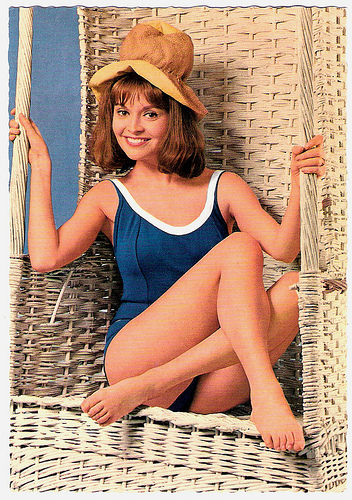
German postcard by Krüger, no. 902/395. Photo: Gérard Decaux.
The Year's Sexiest Screen Newcomer
Yvonne Monlaur was born Countess Yvonne Thérèse Marie Camille Bedat de Monlaur in Pau, France in 1939. Her father was a White Russian count and her mother was a ballet dancer, who had great plans with her daughter. Yvonne followed her mother's footsteps and took ballerina lessons.
She eventually worked as a teenage model for magazines like Elle, when director André Hunebelle discovered her. He gave her small parts in his films Treize à table/Thirteen at the Table (André Hunebelle, 1955) with Micheline Presle , and Mannequins de Paris/Mannequins of Paris (André Hunebelle, 1956) starring Madeleine Robinson . She then had a supporting part in the Fernandel comedy Honoré de Marseille/Honoré from Marseille (Maurice Régamey, 1956).
Then Italian director Franco Rossi called her to Rome for the Italian-Spanish co-production Amore a prima vista/Love at First Sight (Franco Rossi, 1958) starring Walter Chiari . She appeared in more Italian films such as Non sono più Guaglione/I am not Guaglione anymore (Domenico Paolella, 1958) with Sylva Koscina , and Tre straniere a Roma/Three Strangers in Rome (Claudio Gora, 1958) with Claudia Cardinale in one of her first leading roles.
That year Monlaur was also spotted by the British producer Anthony Hinds. He asked to come to England to play in the an episode of the TV series Women in Love (1958) with George Sanders as the host.
In 1959 she suddenly seemed to be ‘hot’ all over Europe. In France a Paris magazine voted her the year's sexiest screen newcomer, in Great Britain she was featured with a four-page pictorial in the September issue of Male magazine and in Italy she is on the cover of a June issue of Tempo magazine and an Italian newspaper called her 'the year's most promising actress'. But during the shooting of the comedy Avventura a Capri/Adventure on Capri (Giuseppe Lipartiti, 1959) she had a serious accident. She suffered bad facial burns in a speedboat accident, resulting in months of recovery at a hospital.
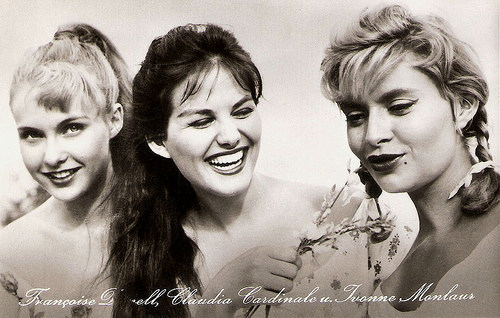
East-German postcard by VEB Progress Filmvertrieb, no. 1187, 1960. Publicity still for Tre straniere a Roma/Three Strangers in Rome (Claudio Gora, 1958) with Francoise Darnell, Claudia Cardinale and Yvonne Monlaur.
Hammer Horror
In 1960 Yvonne Monlaur travelled, accompanied by her mother, to England for a series of films. First she co-starred in the comedy Inn for Trouble (C.M. Pennington-Richards, 1960). Then followed the Hammer horror film The Brides of Dracula (Terence Fisher, 1960). She was introduced in the trailer as 'the latest sex kitten from France'.
Hal Erickson writes at AllMovie : “One of the best of the Hammer horrors, Brides of Dracula stars Peter Cushing as tireless vampire hunter Dr. Van Helsing. Though Drac himself doesn't make an appearance, his influence is felt thanks to teenaged bloodsucker Baron Meinster (David Peel). The baron's loving mother (Martita Hunt) shelters her son from harm, all the while scouring the countryside for potential female victims. When misguided schoolteacher Marianne (Yvonne Monlaur) falls in love with young Meinster, Van Helsing is forced to take drastic measures to show her the error of her ways. Excellent (and very bloody) special effects highlight this sumptuous production.”
In Circus of Horrors (Sidney Hayers, 1960), this time produced by Amalgamated studios, Monlaur appeared alongside Donald Pleasance and Anton Diffring as a deranged German plastic surgeon.
She played a Chinese lady in the Hammer production The Terror of the Tongs (Anthony Bushell, 1961) with Christopher Lee as the vicious leader of a Chinese Tong gang operating in 1910 Hong Kong. Hal Erickson describes it as “a gory, garishly colored melodrama written by Jimmy Sangster in the tradition of the Fu Manchu films.”
Back in Italy she had a small part in the romantic comedy It Started in Naples (Melville Shavelson, 1960) starring Clark Gable and Sophia Loren .
She continued to work in England too and appeared in Time to Remember (Charles Jarrett, 1962), one of a series of second feature films based on Edgar Wallace novels released in the UK between 1960 and 1965.
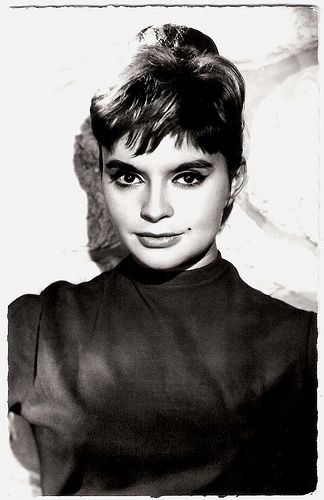
French postcard by Editions du Globe, no. 791. Photo: Studio Vauclair.
Lemmy Caution
In France Yvonne Monlaur played a supporting part in Lemmy pour les dames/Ladies’man (Bernard Borderie, 1962), one of the cult action films starring Eddie Constantine which were based on the crime novels by Peter Cheney.
She stayed in France for the crime comedy À cause, à cause d'une femme/Because of a Woman (Michel Deville, 1963) with Jacques Charrier and Mylène Demongeot , and the crime potboiler Le concerto de la peur/Night of Lust (José Bénazéraf, 1963) with a fabulous free-jazz score by Chet Baker.
The latter was a thriller about two rival mobsters who fight for control of the local drug traffic. The film also included a lesbian nightclub act, which was featured prominently on the international posters.
Monlaur then screentested for the role of Domino Derval in the James Bond film Thunderball (Terence Young, 1965). In his book The James Bond Films (1981), author Steven Jay Rubin features a picture of Monlaur posing in a 'Domino' bathing suit. The role eventually went to another French actress, Claudine Auger .
Yvonne Monlaurs moment seemed to be over. After the German crime thriller Die Rechnung - eiskalt serviert/Tip Not Included (Helmut Ashley, 1966) with George Nader as G-man Jerry Cotton, Monlaur left the cinema to return to France. Her last appearance was in the German TV series Der Tod läuft hinterher/The death runs behind (Wolfgang Becker, 1967) starring Joachim Fuchsberger .
Since then she attended film conventions, and wrote on her official Yvonne Monlaur blog, on which she shared memories of her 1960s Hammer films and other Eurospy and action films. Yvonne Monlaur died of cancer. She was 77.
Trailer for The Brides of Dracula (1960). Source: SuperNaturalEarth (YouTube).
Hammer Homage: The Terror of The Tongs (1961). Source: Time For Toast Productions (YouTube).
Sources: Yvonne Monlaur (Official blog), Hal Erickson (AllMovie), Cult Sirens, Glamour Girls of the Silver Screen, Wikipedia, and .

German postcard by Krüger, no. 902/395. Photo: Gérard Decaux.
The Year's Sexiest Screen Newcomer
Yvonne Monlaur was born Countess Yvonne Thérèse Marie Camille Bedat de Monlaur in Pau, France in 1939. Her father was a White Russian count and her mother was a ballet dancer, who had great plans with her daughter. Yvonne followed her mother's footsteps and took ballerina lessons.
She eventually worked as a teenage model for magazines like Elle, when director André Hunebelle discovered her. He gave her small parts in his films Treize à table/Thirteen at the Table (André Hunebelle, 1955) with Micheline Presle , and Mannequins de Paris/Mannequins of Paris (André Hunebelle, 1956) starring Madeleine Robinson . She then had a supporting part in the Fernandel comedy Honoré de Marseille/Honoré from Marseille (Maurice Régamey, 1956).
Then Italian director Franco Rossi called her to Rome for the Italian-Spanish co-production Amore a prima vista/Love at First Sight (Franco Rossi, 1958) starring Walter Chiari . She appeared in more Italian films such as Non sono più Guaglione/I am not Guaglione anymore (Domenico Paolella, 1958) with Sylva Koscina , and Tre straniere a Roma/Three Strangers in Rome (Claudio Gora, 1958) with Claudia Cardinale in one of her first leading roles.
That year Monlaur was also spotted by the British producer Anthony Hinds. He asked to come to England to play in the an episode of the TV series Women in Love (1958) with George Sanders as the host.
In 1959 she suddenly seemed to be ‘hot’ all over Europe. In France a Paris magazine voted her the year's sexiest screen newcomer, in Great Britain she was featured with a four-page pictorial in the September issue of Male magazine and in Italy she is on the cover of a June issue of Tempo magazine and an Italian newspaper called her 'the year's most promising actress'. But during the shooting of the comedy Avventura a Capri/Adventure on Capri (Giuseppe Lipartiti, 1959) she had a serious accident. She suffered bad facial burns in a speedboat accident, resulting in months of recovery at a hospital.

East-German postcard by VEB Progress Filmvertrieb, no. 1187, 1960. Publicity still for Tre straniere a Roma/Three Strangers in Rome (Claudio Gora, 1958) with Francoise Darnell, Claudia Cardinale and Yvonne Monlaur.
Hammer Horror
In 1960 Yvonne Monlaur travelled, accompanied by her mother, to England for a series of films. First she co-starred in the comedy Inn for Trouble (C.M. Pennington-Richards, 1960). Then followed the Hammer horror film The Brides of Dracula (Terence Fisher, 1960). She was introduced in the trailer as 'the latest sex kitten from France'.
Hal Erickson writes at AllMovie : “One of the best of the Hammer horrors, Brides of Dracula stars Peter Cushing as tireless vampire hunter Dr. Van Helsing. Though Drac himself doesn't make an appearance, his influence is felt thanks to teenaged bloodsucker Baron Meinster (David Peel). The baron's loving mother (Martita Hunt) shelters her son from harm, all the while scouring the countryside for potential female victims. When misguided schoolteacher Marianne (Yvonne Monlaur) falls in love with young Meinster, Van Helsing is forced to take drastic measures to show her the error of her ways. Excellent (and very bloody) special effects highlight this sumptuous production.”
In Circus of Horrors (Sidney Hayers, 1960), this time produced by Amalgamated studios, Monlaur appeared alongside Donald Pleasance and Anton Diffring as a deranged German plastic surgeon.
She played a Chinese lady in the Hammer production The Terror of the Tongs (Anthony Bushell, 1961) with Christopher Lee as the vicious leader of a Chinese Tong gang operating in 1910 Hong Kong. Hal Erickson describes it as “a gory, garishly colored melodrama written by Jimmy Sangster in the tradition of the Fu Manchu films.”
Back in Italy she had a small part in the romantic comedy It Started in Naples (Melville Shavelson, 1960) starring Clark Gable and Sophia Loren .
She continued to work in England too and appeared in Time to Remember (Charles Jarrett, 1962), one of a series of second feature films based on Edgar Wallace novels released in the UK between 1960 and 1965.

French postcard by Editions du Globe, no. 791. Photo: Studio Vauclair.
Lemmy Caution
In France Yvonne Monlaur played a supporting part in Lemmy pour les dames/Ladies’man (Bernard Borderie, 1962), one of the cult action films starring Eddie Constantine which were based on the crime novels by Peter Cheney.
She stayed in France for the crime comedy À cause, à cause d'une femme/Because of a Woman (Michel Deville, 1963) with Jacques Charrier and Mylène Demongeot , and the crime potboiler Le concerto de la peur/Night of Lust (José Bénazéraf, 1963) with a fabulous free-jazz score by Chet Baker.
The latter was a thriller about two rival mobsters who fight for control of the local drug traffic. The film also included a lesbian nightclub act, which was featured prominently on the international posters.
Monlaur then screentested for the role of Domino Derval in the James Bond film Thunderball (Terence Young, 1965). In his book The James Bond Films (1981), author Steven Jay Rubin features a picture of Monlaur posing in a 'Domino' bathing suit. The role eventually went to another French actress, Claudine Auger .
Yvonne Monlaurs moment seemed to be over. After the German crime thriller Die Rechnung - eiskalt serviert/Tip Not Included (Helmut Ashley, 1966) with George Nader as G-man Jerry Cotton, Monlaur left the cinema to return to France. Her last appearance was in the German TV series Der Tod läuft hinterher/The death runs behind (Wolfgang Becker, 1967) starring Joachim Fuchsberger .
Since then she attended film conventions, and wrote on her official Yvonne Monlaur blog, on which she shared memories of her 1960s Hammer films and other Eurospy and action films. Yvonne Monlaur died of cancer. She was 77.
Trailer for The Brides of Dracula (1960). Source: SuperNaturalEarth (YouTube).
Hammer Homage: The Terror of The Tongs (1961). Source: Time For Toast Productions (YouTube).
Sources: Yvonne Monlaur (Official blog), Hal Erickson (AllMovie), Cult Sirens, Glamour Girls of the Silver Screen, Wikipedia, and .
Published on April 22, 2017 22:00
April 21, 2017
Béatrice Altariba
Béatrice Altariba (1939) was the pretty star of many French comedies of the 1950s, often opposite her partner Darry Cowl. Till 1969 she appeared in more than 30 productions, including several Italian films.
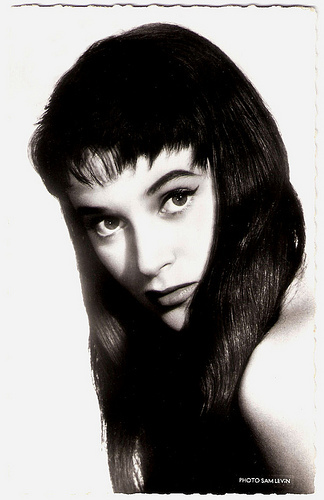
French postcard by Editions du Globe, Paris. Photo Sam Lévin.
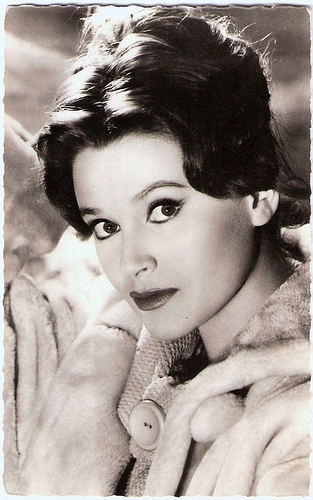
French postcard by Editions du Globe (E.D.U.G.), Paris, no. 733. Photo: Sam Lévin.
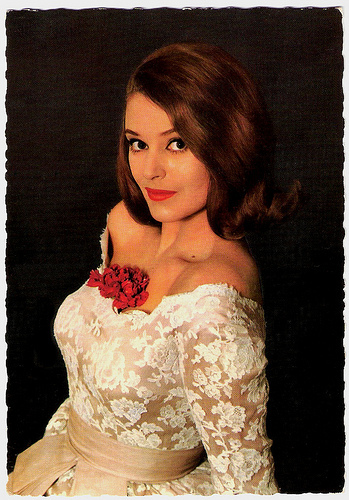
French postcard by Editions du Globe (E.D.U.G.), Paris, no. 204. Photo: Studio Pietri.
Popeline
Béatrice Altariba was born Béatrice Florence Andrée Altarriba in Paris, France in 1939. She is the granddaughter of painter Émile Bernard and the small-niece of symbolist poet Paul Fort.
She started her career in revues and musical theatre, then she made her debut in the cinema at 17 in the French-Italian drama Club de femmes/Women's Club (Ralph Habib, 1956) starring Nicole Courcel , Dany Carrel and Ivan Desny.
Her early film appearances included supporting parts in films like Pardonnez nos offenses/Forgive our insults (Robert Hossein, 1956) starring Marina Vlady , Lorsque l'enfant paraît/When the Child Appears (Michel Boisrond, 1956) with Gaby Morlay , and L'homme et l'enfant/Man and Child (Raoul André, 1956) featuring Eddie Constantine .
Success came when her fiancé at the time, Darry Cowl , made her Popeline, the pretty heroine of the burlesque comedy Le Triporteur/The Tricyclist (Jacques Pinoteau, 1957) and its sequel Robinson et le triporteur/Monsieur Robinson Crusoe (Jacques Pinoteau, 1959).
Meanwhile, they were also partners in other comedies such as L'Ami de la famille/A Friend of the Family (Jacques Pinoteau, 1957), Sois belle et tais-toi/Be Beautiful But Shut Up (Marc Allégret, 1958) starring Mylène Demongeot , and Le Petit Prof/The Little Professor (Carlo Rim, 1959).
Remarkable is also her role as Cosette in Les Misérables (Jean-Paul Le Chanois, 1958), the French-East German-Italian film adaptation of the Victor Hugo novel. It stars Jean Gabin as Jean Valjean and Bernard Blier as Javert. This memorable version was filmed in East Germany and is according to Wikipedia overtly political. It was a massive hit in France, the second most popular of 1958.
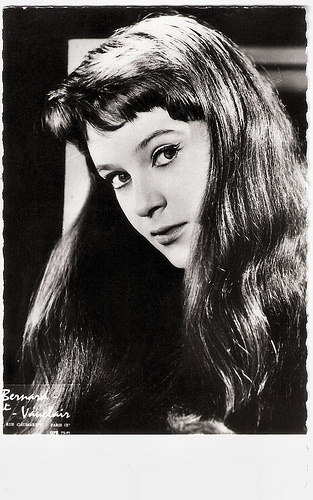
French postcard by Editions P,I,, Paris, offered by Les Carbones Korès 'Carboplane', no. 869. Photo: Bernard et Vauclair, Paris.
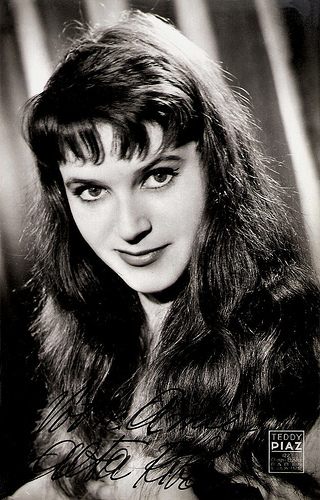
French autograph card. Photo: Teddy Piaz, Paris.
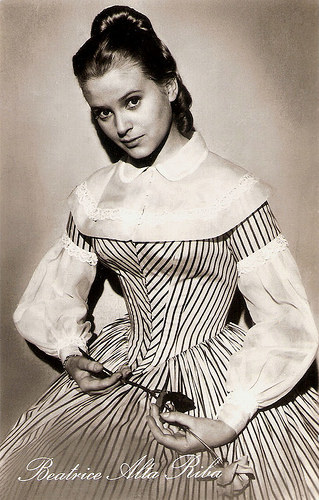
East-German postcard by VEB Progress Film-Vertrieb, no. 141/576, 1959. Photo: DEFA / Corbeau. Publicity still for Les misérables (Jean-Paul Le Chanois, 1958) with Béatrice Altariba as Cosette. The film was a co-production of DEFA (East-Germany), P.A.C. (France), Serena (Italy) and Société Nouvelle Pathé Cinéma (France).
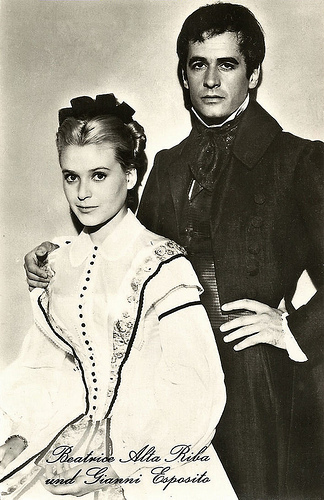
East-German postcard by VEB Progress Film-Vertrieb. Photo: DEFA. Publicity still for Les misérables (Jean-Paul Le Chanois, 1958) with Béatrice Altariba as Cosette and Giani Esposito as Marius.
Beautiful Victim
Without Cowl's assistance, Béatrice Altariba continued her film career successfully into the 1960s. In the excellent horror film Les yeux sans visage/Eyes Without A Face (Georges Franju, 1960) she played one of the young and beautiful victims of a mad surgeon ( Pierre Brasseur ) and his assistant ( Alida Valli ).
The film was influential on several directors, including Spanish director Pedro Almodóvar who stated his La piel que habito/The Skin I Live In (2011), which features Antonio Banderas as a mad scientist who performs skin grafts and surgeries on an unwilling victim, was heavily influenced by Les yeux sans visage.
In Italy, Béatrice Altariba appeared opposite Anita Ekberg in the comedy A porte chiuse/Behind Closed Doors (Dino Risi, 1961) and with Brett Halsey in the historical adventure film Le sette spade del vendicatore/The Seventh Sword (Riccardo Freda, 1962). It is a remake of Freda's debut film Don Cesare di Bazan (1942). She was also Jean-Paul Belmondo ’s mistress in the crime drama Un nommé La Rocca/A Man Named Rocca (Jean Becker, 1961) based on a novel by José Giovanni.
In the American B-film The Young Racers (Roger Corman, 1963) starring Mark Damon, she played a small role. The film was shot on location in Europe to take advantage of the real life grand prix. Again in Italy she played in the Totò comedy Totò diabolicus (Steno, 1963), the parody I quattro moschettieri/The Four Musketeers (Carlo Ludovico Bragaglia, 1963), and in a segment of the anthology film Su e giù/Up and down (Mino Guerrini, 1965).
Her roles got smaller through the late 1960s including an uncredited part in La prisonnière/Female Prisoner (Henri-Georges Clouzot, 1968) starring Laurent Terzieff, and a bit role as a saloon woman in the Spaghetti Western Cimitero senza croci/Cemetery Without Crosses (Robert Hossein, 1969), starring Michèle Mercier and Robert Hossein .
Her last television appearance was in the first episode of the French children's TV series Les chevaliers du ciel/The Aeronauts (1967), based on a comic book series by Jean-Michel Charlier and Albert Uderzo titled Tanguy et Laverdure, about two pilots, and their adventures in the French Air Force.
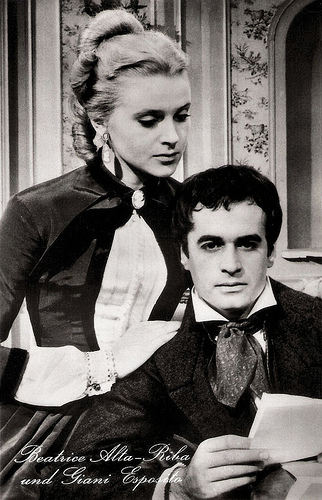
East-German postcard by VEB Progress Film-Vertrieb, no. 951, 1958. Photo: DEFA. Publicity still for Les misérables (Jean-Paul Le Chanois, 1958) with Béatrice Altariba as Cosette and Giani Esposito as Marius.
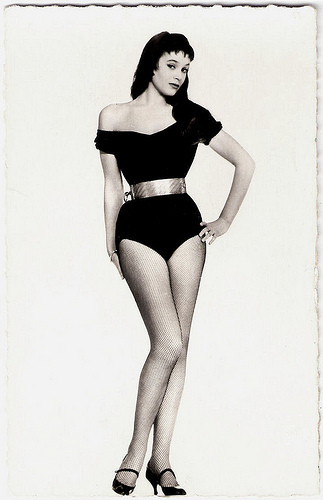
French postcard by Editions du Globe (E.D.U.G.), Paris, no. 679. Photo: Sam Lévin.
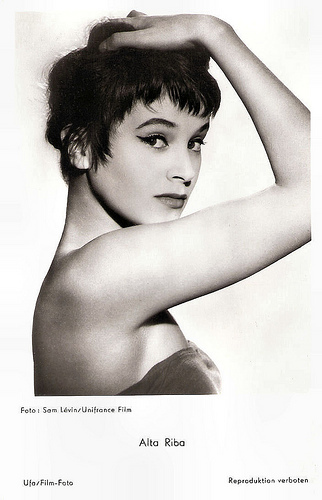
German postcard by UFA, Berlin-Tempelhof, no. FK 3400. Photo: Sam Lévin / Unifrance Film.
Sources: Jean-Pascal Consrtantin (Les Gens du Cinéma), Wikipedia (French and English) and .

French postcard by Editions du Globe, Paris. Photo Sam Lévin.

French postcard by Editions du Globe (E.D.U.G.), Paris, no. 733. Photo: Sam Lévin.

French postcard by Editions du Globe (E.D.U.G.), Paris, no. 204. Photo: Studio Pietri.
Popeline
Béatrice Altariba was born Béatrice Florence Andrée Altarriba in Paris, France in 1939. She is the granddaughter of painter Émile Bernard and the small-niece of symbolist poet Paul Fort.
She started her career in revues and musical theatre, then she made her debut in the cinema at 17 in the French-Italian drama Club de femmes/Women's Club (Ralph Habib, 1956) starring Nicole Courcel , Dany Carrel and Ivan Desny.
Her early film appearances included supporting parts in films like Pardonnez nos offenses/Forgive our insults (Robert Hossein, 1956) starring Marina Vlady , Lorsque l'enfant paraît/When the Child Appears (Michel Boisrond, 1956) with Gaby Morlay , and L'homme et l'enfant/Man and Child (Raoul André, 1956) featuring Eddie Constantine .
Success came when her fiancé at the time, Darry Cowl , made her Popeline, the pretty heroine of the burlesque comedy Le Triporteur/The Tricyclist (Jacques Pinoteau, 1957) and its sequel Robinson et le triporteur/Monsieur Robinson Crusoe (Jacques Pinoteau, 1959).
Meanwhile, they were also partners in other comedies such as L'Ami de la famille/A Friend of the Family (Jacques Pinoteau, 1957), Sois belle et tais-toi/Be Beautiful But Shut Up (Marc Allégret, 1958) starring Mylène Demongeot , and Le Petit Prof/The Little Professor (Carlo Rim, 1959).
Remarkable is also her role as Cosette in Les Misérables (Jean-Paul Le Chanois, 1958), the French-East German-Italian film adaptation of the Victor Hugo novel. It stars Jean Gabin as Jean Valjean and Bernard Blier as Javert. This memorable version was filmed in East Germany and is according to Wikipedia overtly political. It was a massive hit in France, the second most popular of 1958.

French postcard by Editions P,I,, Paris, offered by Les Carbones Korès 'Carboplane', no. 869. Photo: Bernard et Vauclair, Paris.

French autograph card. Photo: Teddy Piaz, Paris.

East-German postcard by VEB Progress Film-Vertrieb, no. 141/576, 1959. Photo: DEFA / Corbeau. Publicity still for Les misérables (Jean-Paul Le Chanois, 1958) with Béatrice Altariba as Cosette. The film was a co-production of DEFA (East-Germany), P.A.C. (France), Serena (Italy) and Société Nouvelle Pathé Cinéma (France).

East-German postcard by VEB Progress Film-Vertrieb. Photo: DEFA. Publicity still for Les misérables (Jean-Paul Le Chanois, 1958) with Béatrice Altariba as Cosette and Giani Esposito as Marius.
Beautiful Victim
Without Cowl's assistance, Béatrice Altariba continued her film career successfully into the 1960s. In the excellent horror film Les yeux sans visage/Eyes Without A Face (Georges Franju, 1960) she played one of the young and beautiful victims of a mad surgeon ( Pierre Brasseur ) and his assistant ( Alida Valli ).
The film was influential on several directors, including Spanish director Pedro Almodóvar who stated his La piel que habito/The Skin I Live In (2011), which features Antonio Banderas as a mad scientist who performs skin grafts and surgeries on an unwilling victim, was heavily influenced by Les yeux sans visage.
In Italy, Béatrice Altariba appeared opposite Anita Ekberg in the comedy A porte chiuse/Behind Closed Doors (Dino Risi, 1961) and with Brett Halsey in the historical adventure film Le sette spade del vendicatore/The Seventh Sword (Riccardo Freda, 1962). It is a remake of Freda's debut film Don Cesare di Bazan (1942). She was also Jean-Paul Belmondo ’s mistress in the crime drama Un nommé La Rocca/A Man Named Rocca (Jean Becker, 1961) based on a novel by José Giovanni.
In the American B-film The Young Racers (Roger Corman, 1963) starring Mark Damon, she played a small role. The film was shot on location in Europe to take advantage of the real life grand prix. Again in Italy she played in the Totò comedy Totò diabolicus (Steno, 1963), the parody I quattro moschettieri/The Four Musketeers (Carlo Ludovico Bragaglia, 1963), and in a segment of the anthology film Su e giù/Up and down (Mino Guerrini, 1965).
Her roles got smaller through the late 1960s including an uncredited part in La prisonnière/Female Prisoner (Henri-Georges Clouzot, 1968) starring Laurent Terzieff, and a bit role as a saloon woman in the Spaghetti Western Cimitero senza croci/Cemetery Without Crosses (Robert Hossein, 1969), starring Michèle Mercier and Robert Hossein .
Her last television appearance was in the first episode of the French children's TV series Les chevaliers du ciel/The Aeronauts (1967), based on a comic book series by Jean-Michel Charlier and Albert Uderzo titled Tanguy et Laverdure, about two pilots, and their adventures in the French Air Force.

East-German postcard by VEB Progress Film-Vertrieb, no. 951, 1958. Photo: DEFA. Publicity still for Les misérables (Jean-Paul Le Chanois, 1958) with Béatrice Altariba as Cosette and Giani Esposito as Marius.

French postcard by Editions du Globe (E.D.U.G.), Paris, no. 679. Photo: Sam Lévin.

German postcard by UFA, Berlin-Tempelhof, no. FK 3400. Photo: Sam Lévin / Unifrance Film.
Sources: Jean-Pascal Consrtantin (Les Gens du Cinéma), Wikipedia (French and English) and .
Published on April 21, 2017 22:00
April 20, 2017
Reinhold Schünzel
German actor and director Reinhold Schünzel (1888-1953) started his successful film career during the first World War. He helmed and appeared in more than 100 productions, specialising in light comedies such as the classic ‘drag’ farce Viktor und Viktoria/Victor and Victoria (1933). In 1937 he had to flee Nazi-Germany and continued his career in Hollywood.
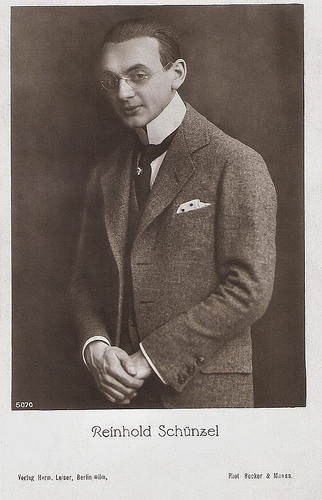
German postcard by Verlag Herm. Leiser, Berlin-Wilm., no. 5070. Photo: Becker & Maass.
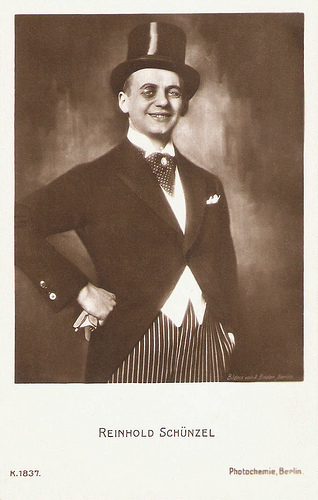
German postcard by Photochemie, Berlin, no. K. 1837. Photo: Alex Binder, Berlin.
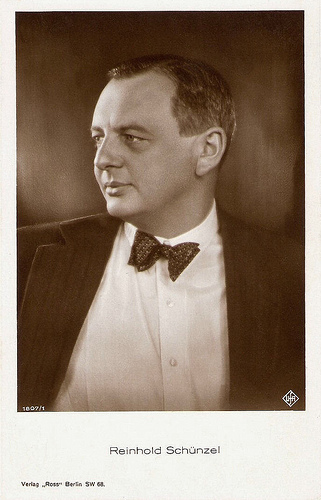
German postcard by Ross Verlag, Berlin, no. 1907/1, 1927-1928. Photo: Ufa.
Self-indulgent Bonvivant and Seducer
Reinhold Schünzel was born in Hamburg, Germany, in 1888 (some sources: 1886). After finishing school, he completed an apprenticeship as a merchant in the Berlin-based publishing company Scherl. He then worked in Berlin, later in Hamburg, as a branch manager for the publishing company.
Besides, he worked as a part-time extra in films. He became a full-time actor in 1912. He then performed at Stadttheater Bern and at Berlin's Komödienhaus at Schiffbauerdamm and at Theater at Königgrätzer Straße. His film debut was in Werner Krafft (Carl Froelich, 1916) with Erika Glässner .
In the same year he was discovered by Richard Oswald. From then on he often played the part of the self-indulgent bonvivant and seducer, the sly pander and extortionist in Oswald's films. He starred in the Aufklärungsfilms (educational film) Das Tagebuch einer Verlorenen/The Diary of a Lost Woman (Richard Oswald, 1918) with Erna Morena , Werner Krauss , and Conrad Veidt , and Das gelbe Haus/Prostitution (Richard Oswald, 1919) starring Anita Berber .
With Veidt he starred in Anders als die Andern/Different from the Others (Richard Oswald, 1919), where he embodied the blackmailer of a homosexual violinist, played by Veidt. He also appeared as the villain in the crime films of the Max Landa series, such as Das Geheimnis des Amerika-Docks/The Secret of the America Dock (Ewald André Dupont, 1919).
In 1919 he directed his first film, Maria Magdalena/Mary Magdalena (Reinhold Schünzel, 1919) with Lucie Höflich. He followed this up with the Aufklärungsfilm Das Mädchen aus der Ackerstraße/The Girl From the Ackerstrasse (1920) and the elaborate history film Katharina die Große/Catherine the Great (1920).
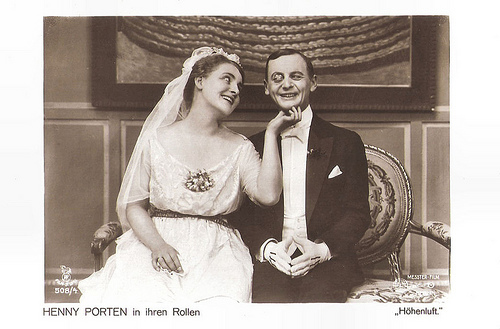
German postcard by Film-Sterne Verlag, no. 508/4. Henny Porten and Reinhold Schünzel in the Messter comedy Höhenluft (Rudolf Biebrach, 1917).
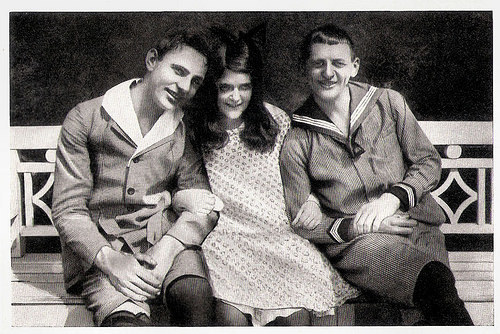
German collectors card by Ross Verlag for the album Vom Werden deutscher Filmkunst. Teil I. Der stumme Film (Cigaretten-Bilderdienst Altona-Bahrenfeld 1935), Bild no. 43, Gruppe 41. Photo: Treumann-Larsen-Film. Publicity still for Die Erzkokette/The Superflirt (Franz Eckstein, Rosa Porten, 1917) with left Eduard von Winterstein and Rosa Porten .
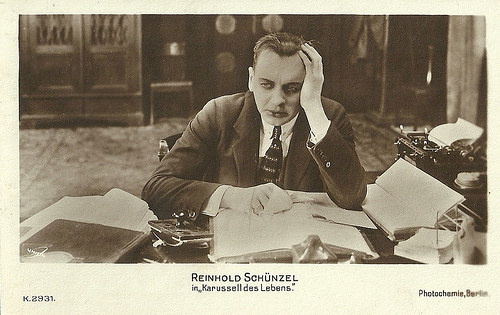
German postcard by Photochemie, Berlin, no. K.2931. Photo: Union. Reinhold Schünzel in Das Karussell des Lebens (Georg Jacoby, 1918). According to German Wikipedia Schünzel's presence in the film is unsure, but this postcard seems to prove it.
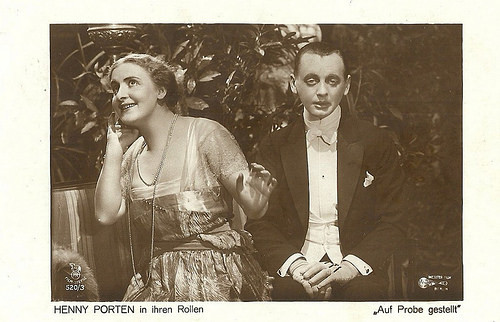
German postcard in the Film Sterne series by Rotophot, no. 520/3. Photo: Messter Film. Henny Porten and Reinhold Schünzel in the German silent comedy Auf Probe gestellt (Rudolf Biebrach, 1918).
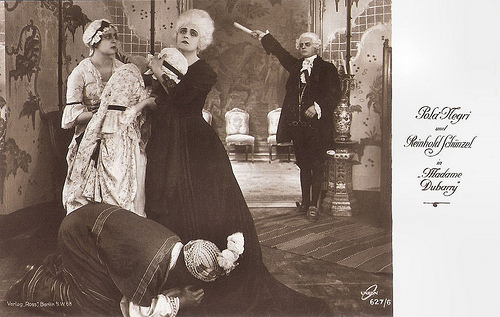
German postcard by Ross Verlag, no. 627/6. Photo: Union Film. Publicity still of Reinhold Schünzel and Pola Negri in Madame DuBarry (Ernst Lubitsch, 1919). After the death of King Louis XV ( Emil Jannings ), his minister Choiseul (Schünzel) chases DuBarry (Negri) from the Royal palace.
Classic Drag Farce
Still in 1920, Reinhold Schünzel set up the production company Schünzel-Film and merged it several months later with the Vienna-based production company Micheluzzo & Co. (Micco-Film). The new production company then produced Der Graf von Cagliostro/The Count of Cagliostro (1920), starring Conrad Veidt and Anita Berber . Schünzel helmed the film as producer, director and actor.
Schünzel also starred in ambitious productions like Madame Dubarry/Passion (Ernst Lubitsch, 1919) starring Pola Negri , and the Friedrich Schiller adaption Luise Millerin (Carl Froelich, 1922) featuring Lil Dagover .
From the second half of the 1920s on he specialised as a director in light comedies. He displayed his full comedic potential in films such as Adam und Eva/Adam and Eve (1923), Halloh Caesar!/Hello Cesar! (1926), and Don Juan in der Mädchenschule/Don Juan in the Girl’s School (1928) with Adolphe Engers .
Even when he was at his busiest as a director, Schünzel found time to act in other men's films, notably Georg Wilhelm Pabst’s adaptation of Die 3-Groschen-Oper/The Beggar's Opera (G.W. Pabst, 1931), in which he played crooked constable Tiger Brown.
With the introduction of sound film his comic talent as a director came even to better advantage. From 1931 on, Schünzel worked as a director for Ufa and finished a number of very successful musical films, including Saison in Kairo/Cairo Season (1933), the classic ‘drag’ farce Viktor und Viktoria/Victor and Victoria (1933), and Amphitryon - the clouds comes from the happiness/Amphitryon – Aus den Wolken kommt das Glück (1935). In all these film Renate Müller played the leading role.
Schünzel also directed the simultaneously film French-language version of Viktor und Viktoria: George et Georgette (Roger Le Bon, Reinhold Schünzel, 1933) starring Meg Lemonnier . Viktor und Viktoria would also lead to such remakes as Victor, Victoria (Blake Edwards, 1981) starring Julie Andrews .
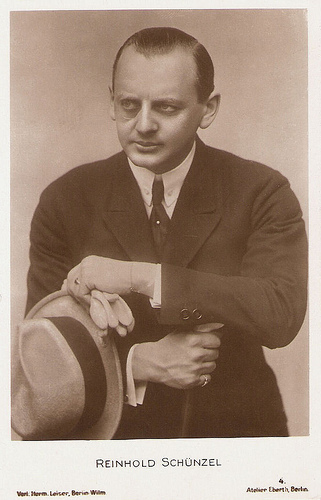
German postcard by Herm. Leiser, Berlin-Wilm. Photo: Atelier Eberth, Berlin.
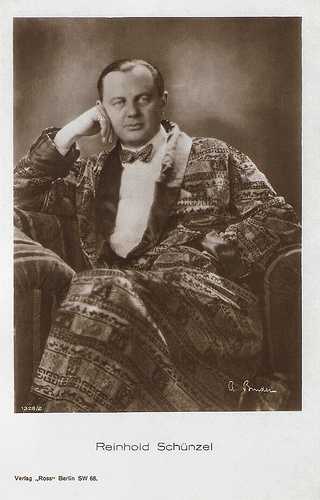
German postcard by Ross Verlag, no. 1328/2, 1927-1928. Photo: Alex Binder.
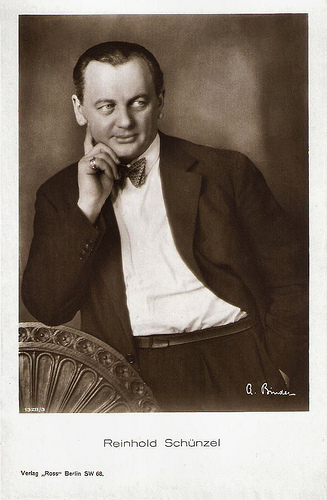
German postcard by Ross Verlag, no. 1328/3, 1927-1928. Photo: Alex Binder.
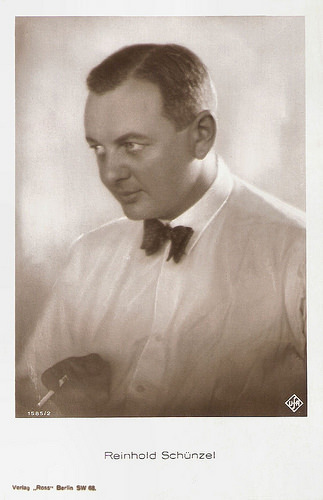
German postcard by Ross Verlag, no. 1585/2, 1927-1928. Photo: Ufa.
Half-Jew
After 1933, Reinhold Schünzel was only by special permission of the Nazis allowed to work because he was described as ‘half-Jew’. Though he tried to make the best of things after Adolph Hitler's ascent to power, the ironic undertone of his films eventually got Schünzel in trouble with the Nazi regime. There were so many interventions in his films that he left the country after finishing Land der Liebe/Land of Love (1937) with Albert Matterstock .
He resettled in Hollywood. His American directorial debut was Rich Man Poor Girl (1938). Although the three musical films he made for MGM were quite successful - the others were Balalaika (1939) and The Ice Follies of 1939 (1939) - and featured stars like Joan Crawford and James Stewart, Schünzel was not able to make his breakthrough in Hollywood. Thus, New Wine (1941) happened to be his last film as a director.
From then on he concentrated solely on playing character roles. He appeared as a Nazi villain in major films as Hangmen Also Die! (Fritz Lang, 1943) and Notorious (Alfred Hitchcock, 1946). Amidst the requisite Nazis and Professorial types, Schünzel enjoyed one of his best-ever screen roles in Paramount's The Man in Half-Moon Street (Ralph Murphy, 1945), playing the conscience-stricken associate of murderous ‘eternal-life’ experimenter Nils Asther .
In 1949 (some sources say 1952) he returned to Germany and worked again at on stage in Munich, as he appeared as a supporting actor in films. For his role in Meines Vaters Pferde/My father's horses (Gerhard Lamprecht, 1954), he received the Bundesfilmpreis (Federal Film Award) as Best Male Supporting Actor.
Shortly after, Reinhold Schünzel died in Munich of a heart disease. He was the father of Marianne Stewart. On the occasion of Schünzel’s 100th Birthday in 1988, CineGraph – the Hamburg Institute Center for Film Research dedicated a congress to the work of the director and actor.
Subsequently a biography was published: Reinhold Schunzel: Schaupieler und Regisseur (1989), by Hans-Michael Bock, Wolfgang Jacobson, and Joerg Schoening. The publication inspired Hans-Christoph Blumenberg to make a film about Schünzel, Beim nächsten Kuß knall ich ihn nieder!/The Next Kiss I’ll Shoot Him! (1995). Since 2004 CineFest, the International Festival of German Film Heritage, has the Reinhold Schünzel Award, a yearly honorary award for long service to the care, preservation and dissemination of the German film heritage.
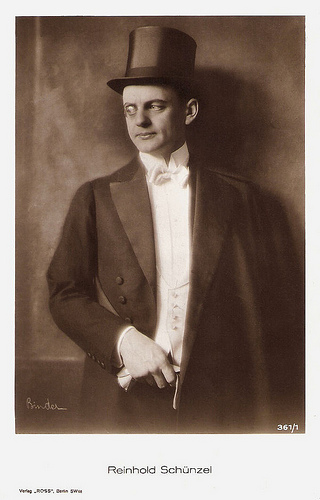
German postcard by Ross Verlag, Berlin, no. 361/1. Photo: Alex Binder, Berlin.
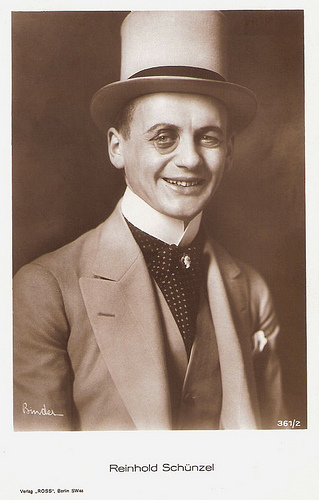
German postcard by Ross Verlag, Berlin, no. 361/2. Photo: Alex Binder, Berlin.
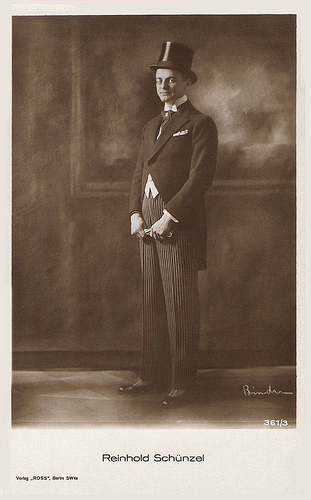
German postcard by Ross Verlag, Berlin, no. 361/3, 1919-1924. Photo: Alex Binder.
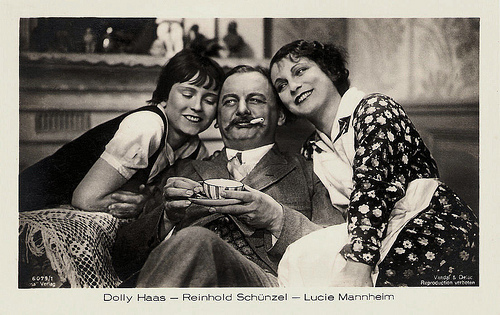
German postcard by Ross Verlag, no. 6079/1, 1931-1932. Photo: Vandal & Delac. Publicity still for Der Ball/The Ball (Wilhelm Thiele, 1931) with Dolly Haas and Lucie Mannheim.
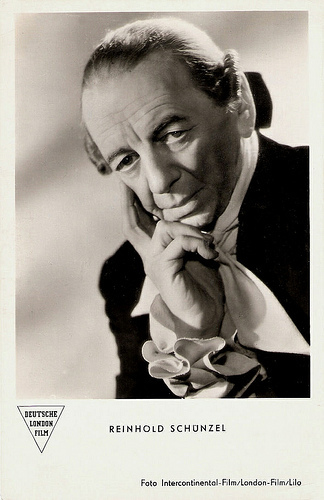
German postcard by Deutsche London Film. Photo: Intercontinental-Film / London-Film / Lilo.
Sources: Hal Erickson (AllMovie), Thomas Staedeli (Cyranos), Filmportal.de, TCM, Wikipedia (German), and .

German postcard by Verlag Herm. Leiser, Berlin-Wilm., no. 5070. Photo: Becker & Maass.

German postcard by Photochemie, Berlin, no. K. 1837. Photo: Alex Binder, Berlin.

German postcard by Ross Verlag, Berlin, no. 1907/1, 1927-1928. Photo: Ufa.
Self-indulgent Bonvivant and Seducer
Reinhold Schünzel was born in Hamburg, Germany, in 1888 (some sources: 1886). After finishing school, he completed an apprenticeship as a merchant in the Berlin-based publishing company Scherl. He then worked in Berlin, later in Hamburg, as a branch manager for the publishing company.
Besides, he worked as a part-time extra in films. He became a full-time actor in 1912. He then performed at Stadttheater Bern and at Berlin's Komödienhaus at Schiffbauerdamm and at Theater at Königgrätzer Straße. His film debut was in Werner Krafft (Carl Froelich, 1916) with Erika Glässner .
In the same year he was discovered by Richard Oswald. From then on he often played the part of the self-indulgent bonvivant and seducer, the sly pander and extortionist in Oswald's films. He starred in the Aufklärungsfilms (educational film) Das Tagebuch einer Verlorenen/The Diary of a Lost Woman (Richard Oswald, 1918) with Erna Morena , Werner Krauss , and Conrad Veidt , and Das gelbe Haus/Prostitution (Richard Oswald, 1919) starring Anita Berber .
With Veidt he starred in Anders als die Andern/Different from the Others (Richard Oswald, 1919), where he embodied the blackmailer of a homosexual violinist, played by Veidt. He also appeared as the villain in the crime films of the Max Landa series, such as Das Geheimnis des Amerika-Docks/The Secret of the America Dock (Ewald André Dupont, 1919).
In 1919 he directed his first film, Maria Magdalena/Mary Magdalena (Reinhold Schünzel, 1919) with Lucie Höflich. He followed this up with the Aufklärungsfilm Das Mädchen aus der Ackerstraße/The Girl From the Ackerstrasse (1920) and the elaborate history film Katharina die Große/Catherine the Great (1920).

German postcard by Film-Sterne Verlag, no. 508/4. Henny Porten and Reinhold Schünzel in the Messter comedy Höhenluft (Rudolf Biebrach, 1917).

German collectors card by Ross Verlag for the album Vom Werden deutscher Filmkunst. Teil I. Der stumme Film (Cigaretten-Bilderdienst Altona-Bahrenfeld 1935), Bild no. 43, Gruppe 41. Photo: Treumann-Larsen-Film. Publicity still for Die Erzkokette/The Superflirt (Franz Eckstein, Rosa Porten, 1917) with left Eduard von Winterstein and Rosa Porten .

German postcard by Photochemie, Berlin, no. K.2931. Photo: Union. Reinhold Schünzel in Das Karussell des Lebens (Georg Jacoby, 1918). According to German Wikipedia Schünzel's presence in the film is unsure, but this postcard seems to prove it.

German postcard in the Film Sterne series by Rotophot, no. 520/3. Photo: Messter Film. Henny Porten and Reinhold Schünzel in the German silent comedy Auf Probe gestellt (Rudolf Biebrach, 1918).

German postcard by Ross Verlag, no. 627/6. Photo: Union Film. Publicity still of Reinhold Schünzel and Pola Negri in Madame DuBarry (Ernst Lubitsch, 1919). After the death of King Louis XV ( Emil Jannings ), his minister Choiseul (Schünzel) chases DuBarry (Negri) from the Royal palace.
Classic Drag Farce
Still in 1920, Reinhold Schünzel set up the production company Schünzel-Film and merged it several months later with the Vienna-based production company Micheluzzo & Co. (Micco-Film). The new production company then produced Der Graf von Cagliostro/The Count of Cagliostro (1920), starring Conrad Veidt and Anita Berber . Schünzel helmed the film as producer, director and actor.
Schünzel also starred in ambitious productions like Madame Dubarry/Passion (Ernst Lubitsch, 1919) starring Pola Negri , and the Friedrich Schiller adaption Luise Millerin (Carl Froelich, 1922) featuring Lil Dagover .
From the second half of the 1920s on he specialised as a director in light comedies. He displayed his full comedic potential in films such as Adam und Eva/Adam and Eve (1923), Halloh Caesar!/Hello Cesar! (1926), and Don Juan in der Mädchenschule/Don Juan in the Girl’s School (1928) with Adolphe Engers .
Even when he was at his busiest as a director, Schünzel found time to act in other men's films, notably Georg Wilhelm Pabst’s adaptation of Die 3-Groschen-Oper/The Beggar's Opera (G.W. Pabst, 1931), in which he played crooked constable Tiger Brown.
With the introduction of sound film his comic talent as a director came even to better advantage. From 1931 on, Schünzel worked as a director for Ufa and finished a number of very successful musical films, including Saison in Kairo/Cairo Season (1933), the classic ‘drag’ farce Viktor und Viktoria/Victor and Victoria (1933), and Amphitryon - the clouds comes from the happiness/Amphitryon – Aus den Wolken kommt das Glück (1935). In all these film Renate Müller played the leading role.
Schünzel also directed the simultaneously film French-language version of Viktor und Viktoria: George et Georgette (Roger Le Bon, Reinhold Schünzel, 1933) starring Meg Lemonnier . Viktor und Viktoria would also lead to such remakes as Victor, Victoria (Blake Edwards, 1981) starring Julie Andrews .

German postcard by Herm. Leiser, Berlin-Wilm. Photo: Atelier Eberth, Berlin.

German postcard by Ross Verlag, no. 1328/2, 1927-1928. Photo: Alex Binder.

German postcard by Ross Verlag, no. 1328/3, 1927-1928. Photo: Alex Binder.

German postcard by Ross Verlag, no. 1585/2, 1927-1928. Photo: Ufa.
Half-Jew
After 1933, Reinhold Schünzel was only by special permission of the Nazis allowed to work because he was described as ‘half-Jew’. Though he tried to make the best of things after Adolph Hitler's ascent to power, the ironic undertone of his films eventually got Schünzel in trouble with the Nazi regime. There were so many interventions in his films that he left the country after finishing Land der Liebe/Land of Love (1937) with Albert Matterstock .
He resettled in Hollywood. His American directorial debut was Rich Man Poor Girl (1938). Although the three musical films he made for MGM were quite successful - the others were Balalaika (1939) and The Ice Follies of 1939 (1939) - and featured stars like Joan Crawford and James Stewart, Schünzel was not able to make his breakthrough in Hollywood. Thus, New Wine (1941) happened to be his last film as a director.
From then on he concentrated solely on playing character roles. He appeared as a Nazi villain in major films as Hangmen Also Die! (Fritz Lang, 1943) and Notorious (Alfred Hitchcock, 1946). Amidst the requisite Nazis and Professorial types, Schünzel enjoyed one of his best-ever screen roles in Paramount's The Man in Half-Moon Street (Ralph Murphy, 1945), playing the conscience-stricken associate of murderous ‘eternal-life’ experimenter Nils Asther .
In 1949 (some sources say 1952) he returned to Germany and worked again at on stage in Munich, as he appeared as a supporting actor in films. For his role in Meines Vaters Pferde/My father's horses (Gerhard Lamprecht, 1954), he received the Bundesfilmpreis (Federal Film Award) as Best Male Supporting Actor.
Shortly after, Reinhold Schünzel died in Munich of a heart disease. He was the father of Marianne Stewart. On the occasion of Schünzel’s 100th Birthday in 1988, CineGraph – the Hamburg Institute Center for Film Research dedicated a congress to the work of the director and actor.
Subsequently a biography was published: Reinhold Schunzel: Schaupieler und Regisseur (1989), by Hans-Michael Bock, Wolfgang Jacobson, and Joerg Schoening. The publication inspired Hans-Christoph Blumenberg to make a film about Schünzel, Beim nächsten Kuß knall ich ihn nieder!/The Next Kiss I’ll Shoot Him! (1995). Since 2004 CineFest, the International Festival of German Film Heritage, has the Reinhold Schünzel Award, a yearly honorary award for long service to the care, preservation and dissemination of the German film heritage.

German postcard by Ross Verlag, Berlin, no. 361/1. Photo: Alex Binder, Berlin.

German postcard by Ross Verlag, Berlin, no. 361/2. Photo: Alex Binder, Berlin.

German postcard by Ross Verlag, Berlin, no. 361/3, 1919-1924. Photo: Alex Binder.

German postcard by Ross Verlag, no. 6079/1, 1931-1932. Photo: Vandal & Delac. Publicity still for Der Ball/The Ball (Wilhelm Thiele, 1931) with Dolly Haas and Lucie Mannheim.

German postcard by Deutsche London Film. Photo: Intercontinental-Film / London-Film / Lilo.
Sources: Hal Erickson (AllMovie), Thomas Staedeli (Cyranos), Filmportal.de, TCM, Wikipedia (German), and .
Published on April 20, 2017 22:00
April 19, 2017
Resurrezione (1917)
The Italian silent film Resurrezione/Resurrection (Mario Caserini, 1917) starred diva Maria Jacobini and André Habay. The Tiber-film production was based on Leo Tolstoy's powerful novel.
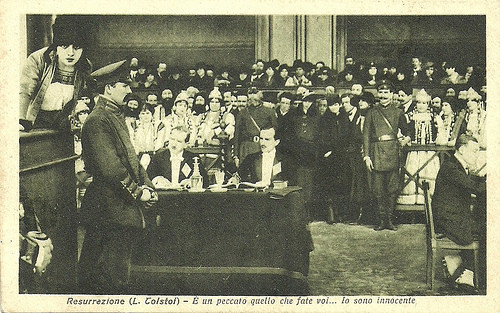
Italian postcard for Resurrezione (Mario Caserini, 1917) with Maria Jacobini . Caption: It is a sin what you're doing... I am innocent.
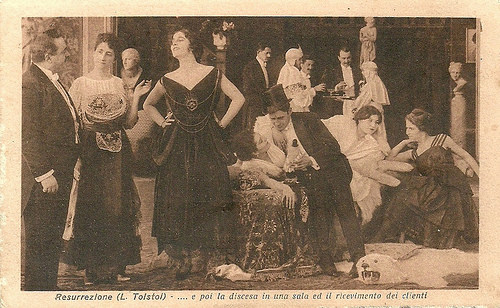
Italian postcard for Resurrezione (Mario Caserini, 1917) with Maria Jacobini . Caption: ... and then descending to a room and the reception of the guests.
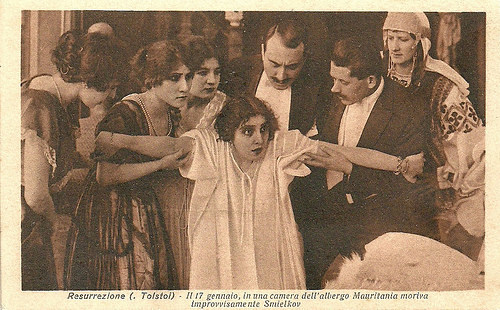
Italian postcard for Resurrezione (Mario Caserini, 1917) with Maria Jacobini . Caption: On 17 January in a room of Hotel Mauritania, Smielkov suddenly died.
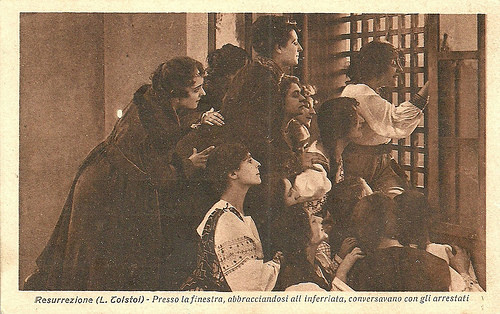
Italian postcard for Resurrezione (Mario Caserini, 1917). Caption: Close to the window, holding the iron grill, they talked to the arrested.
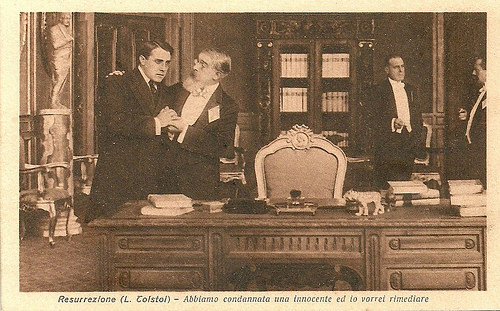
Italian postcard for Resurrezione (Mario Caserini, 1917) with André Habay . Caption: We have sentenced an innocent and I want to repair.
Forced into prostitution
Resurrezione/Resurrection (1917) is based on the novel Voskreseniye, first published in 1899. It was the last novel written by Leo Tolstoy. The novel had already been filmed before by D.W. Griffith in 1909 as Resurrection and in Russia as Katyusha Maslova (Pyotr Chardynin, 1915), the first film role of Natalya Lisenko (or Nathalie Lissenko).
While member of a jury, the rich Prince Dmitri Ivanovich Nekhlyudov ( André Habay ) recognises the accused Katusa Maslova ( Maria Jacobini ). She is the girl who was once a maid in his family and whom he seduced, forcing her into prostitution.
She is framed for the murder of a business man and sent to Siberia. Dmitri visits her in prison, hears other stories of other prisoners and realises his gilded life and class justice. Even when loving him back, Maslova refuses to marry him, as she wants to free him from her.
Tolstoy intended the novel as an exposition of the injustice of man-made laws and the hypocrisy of the institutionalised church. The novel also explores the economic philosophy of Georgism, of which Tolstoy had become a very strong advocate towards the end of his life, and explains the theory in detail. It was first published serially in the popular weekly magazine Niva in an effort to raise funds for the resettlement of the Doukhobors.
Resurrezione/Resurrection (Mario Caserini, 1917) premiered in Rome on 26 April 1917. Other film adaptations include the Italian film Resurrection (1944); a Chinese film version entitled 蕩婦心/A Forgotten Woman (1944) starring Bai Guang; a Russian film version directed by Mikhail Shveitser in 1960, with Yevgeny Matveyev. The best-known film version, however, is Samuel Goldwyn's English-language We Live Again (Rouben Mamoulian, 1934) with Fredric March and Anna Sten . Finally, the Italian directors Paolo and Vittorio Taviani released a TV film Resurrezione in 2001.
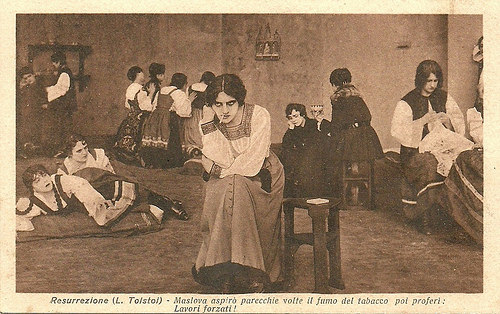
Italian postcard for Resurrezione (Mario Caserini, 1917) with Maria Jacobini . Caption: Maslova inhaled the tobacco's smoke a few times, then uttered: Forced labour!
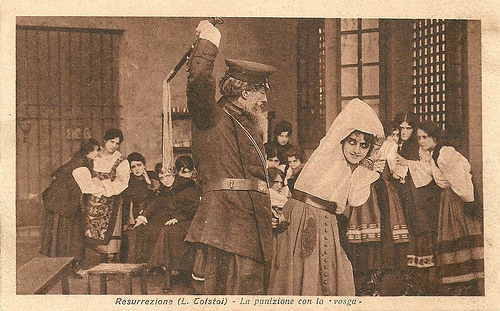
Italian postcard for Resurrezione (Mario Caserini, 1917) with Maria Jacobini . Caption: the punishment with the 'vosga' (like a cat o'nine tails).
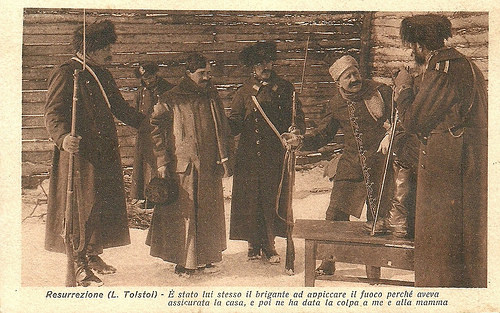
Italian postcard for Resurrezione (Mario Caserini, 1917). Caption: It is this bandit himself who has set the house on fire because he had insured it, and then he blamed my mother and me for it.
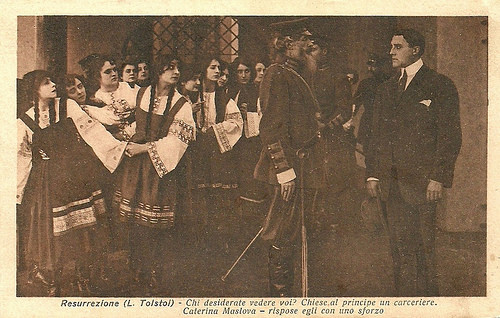
Italian postcard for Resurrezione (Mario Caserini, 1917) with André Habay . Caption: Who do you wish to see? the guardian asked the prince. Katerina Maslova, he answered him with difficulty.
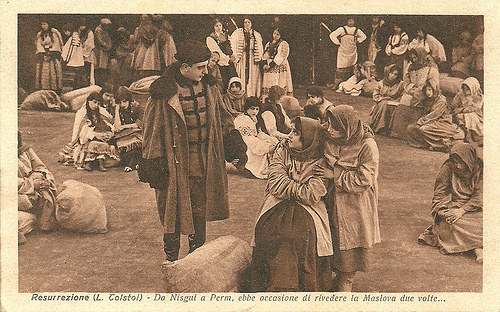
Italian postcard for Resurrezione (Mario Caserini, 1917) with Maria Jacobini and André Habay . Caption: From Nisgui to Perm he had twice occasion to see Maslova again.
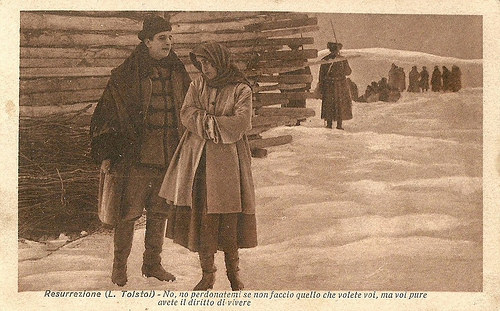
Italian postcard for Resurrezione (Mario Caserini, 1917) with Maria Jacobini and André Habay . Caption: Non, don't forgive me if I don't do what you want, but you have a right to live too.
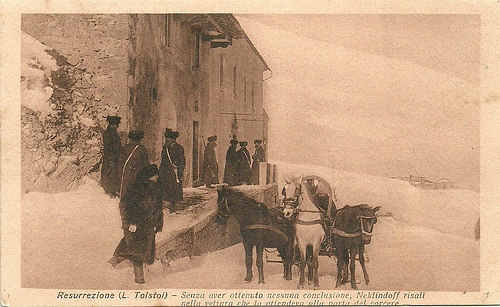
Italian postcard for Resurrezione (Mario Caserini, 1917). Caption: Unable to have obtained anything, Neklindoff got back into the carriage which waited form him at the prison's gate.
Sources: Wikipedia (English and Italian) and IMDb.

Italian postcard for Resurrezione (Mario Caserini, 1917) with Maria Jacobini . Caption: It is a sin what you're doing... I am innocent.

Italian postcard for Resurrezione (Mario Caserini, 1917) with Maria Jacobini . Caption: ... and then descending to a room and the reception of the guests.

Italian postcard for Resurrezione (Mario Caserini, 1917) with Maria Jacobini . Caption: On 17 January in a room of Hotel Mauritania, Smielkov suddenly died.

Italian postcard for Resurrezione (Mario Caserini, 1917). Caption: Close to the window, holding the iron grill, they talked to the arrested.

Italian postcard for Resurrezione (Mario Caserini, 1917) with André Habay . Caption: We have sentenced an innocent and I want to repair.
Forced into prostitution
Resurrezione/Resurrection (1917) is based on the novel Voskreseniye, first published in 1899. It was the last novel written by Leo Tolstoy. The novel had already been filmed before by D.W. Griffith in 1909 as Resurrection and in Russia as Katyusha Maslova (Pyotr Chardynin, 1915), the first film role of Natalya Lisenko (or Nathalie Lissenko).
While member of a jury, the rich Prince Dmitri Ivanovich Nekhlyudov ( André Habay ) recognises the accused Katusa Maslova ( Maria Jacobini ). She is the girl who was once a maid in his family and whom he seduced, forcing her into prostitution.
She is framed for the murder of a business man and sent to Siberia. Dmitri visits her in prison, hears other stories of other prisoners and realises his gilded life and class justice. Even when loving him back, Maslova refuses to marry him, as she wants to free him from her.
Tolstoy intended the novel as an exposition of the injustice of man-made laws and the hypocrisy of the institutionalised church. The novel also explores the economic philosophy of Georgism, of which Tolstoy had become a very strong advocate towards the end of his life, and explains the theory in detail. It was first published serially in the popular weekly magazine Niva in an effort to raise funds for the resettlement of the Doukhobors.
Resurrezione/Resurrection (Mario Caserini, 1917) premiered in Rome on 26 April 1917. Other film adaptations include the Italian film Resurrection (1944); a Chinese film version entitled 蕩婦心/A Forgotten Woman (1944) starring Bai Guang; a Russian film version directed by Mikhail Shveitser in 1960, with Yevgeny Matveyev. The best-known film version, however, is Samuel Goldwyn's English-language We Live Again (Rouben Mamoulian, 1934) with Fredric March and Anna Sten . Finally, the Italian directors Paolo and Vittorio Taviani released a TV film Resurrezione in 2001.

Italian postcard for Resurrezione (Mario Caserini, 1917) with Maria Jacobini . Caption: Maslova inhaled the tobacco's smoke a few times, then uttered: Forced labour!

Italian postcard for Resurrezione (Mario Caserini, 1917) with Maria Jacobini . Caption: the punishment with the 'vosga' (like a cat o'nine tails).

Italian postcard for Resurrezione (Mario Caserini, 1917). Caption: It is this bandit himself who has set the house on fire because he had insured it, and then he blamed my mother and me for it.

Italian postcard for Resurrezione (Mario Caserini, 1917) with André Habay . Caption: Who do you wish to see? the guardian asked the prince. Katerina Maslova, he answered him with difficulty.

Italian postcard for Resurrezione (Mario Caserini, 1917) with Maria Jacobini and André Habay . Caption: From Nisgui to Perm he had twice occasion to see Maslova again.

Italian postcard for Resurrezione (Mario Caserini, 1917) with Maria Jacobini and André Habay . Caption: Non, don't forgive me if I don't do what you want, but you have a right to live too.

Italian postcard for Resurrezione (Mario Caserini, 1917). Caption: Unable to have obtained anything, Neklindoff got back into the carriage which waited form him at the prison's gate.
Sources: Wikipedia (English and Italian) and IMDb.
Published on April 19, 2017 22:00
April 18, 2017
Boris Karloff
British actor Boris Karloff (1887-1969) is one of the true icons of the Horror cinema. He portrayed Frankenstein's monster in Frankenstein (1931), Bride of Frankenstein (1935), and Son of Frankenstein (1939), which resulted in his immense popularity. In the following decades he worked in countless Horror films, but also in other genres, both in Europe and Hollywood.
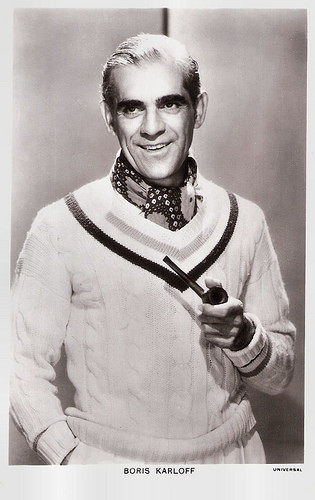
British postcard in the Picturegoer series, London, no 707 H. Photo: Universal.
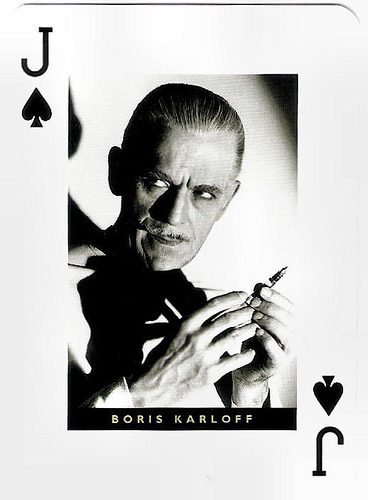
Vintage playing card.
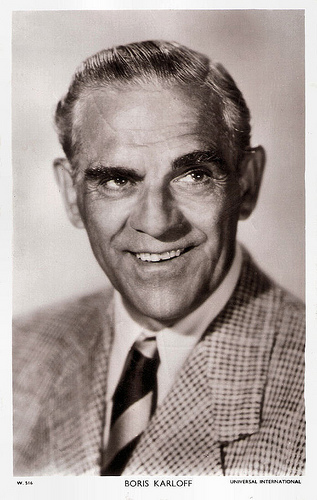
British postcard in the Picturegoer series, London, no W 516. Photo: Universal International.
An exotic Arabian or Indian villain
Boris Karloff was born as William Henry Pratt in 1887 in London, England. Pratt himself stated that he was born in Dulwich, which is nearby London. His parents were Edward John Pratt, Jr. and his third wife Eliza Sarah Millard.
‘Billy’ never knew his father. Edward Pratt had worked for the Indian Salt Revenue Service, and had virtually abandoned his family in far off England. Edward died when his son was still an infant and so Billy was raised by his mother. He was the youngest of nine children, and following his mother's death was brought up by his elder brothers and sisters.
As a child, Billy performed each Christmas in plays staged by St. Mary Magdalene's Church. His first role was that of The Demon King in the pantomime Cinderella. Billy was bow-legged, had a lisp, and stuttered. He conquered his stutter, but not his lisp, which was noticeable throughout his career in the film industry.
After his education at private schools, he attended King's College London where he took studies aimed at a career with the British Government's Consular Service. However, in 1909, the 22-years-old left university without graduating and sailed from Liverpool to Canada, where he worked as a farm labourer and did various odd itinerant jobs.
In Canada, he began appearing in theatrical performances, and chose the stage name Boris Karloff. Later, he claimed he chose ‘Boris’ because it sounded foreign and exotic, and that ‘Karloff’ was a family name. However, his daughter Sara Karloff publicly denied any knowledge of Slavic forebears, Karloff or otherwise.
One reason for the name change was to prevent embarrassment to his family. He did not reunite with his family until he returned to Britain to make The Ghoul (T. Hayes Hunter, 1933), opposite Cedric Hardwicke . Karloff was extremely worried that his family would disapprove of his new, macabre claim to world fame. Instead, his brothers jostled for position around him and happily posed for publicity photographs.
In 1911, Karloff joined the Jeanne Russell Company and later joined the Harry St. Clair Co. that performed in Minot, North Dakota, for a year in an opera house above a hardware store. Whilst he was trying to establish his acting career, Karloff had to perform years of difficult manual labour in Canada and the U.S. in order to make ends meet. He was left with back problems from which he suffered for the rest of his life.
In 1917, he arrived in Hollywood, where he went on to make dozens of silent films. Some of his first roles were in film serials, such as The Masked Rider (Aubrey M. Kennedy, 1919), in Chapter 2 of which he can be glimpsed onscreen for the first time, and The Hope Diamond Mystery (Stuart Paton, 1920). In these early roles, he was often cast as an exotic Arabian or Indian villain.
Other silent films were The Deadlier Sex (Robert Thornby, 1920) with Blanche Sweet, Omar the Tentmaker (James Young, 1922), Dynamite Dan (Bruce Mitchell, 1924) and Tarzan and the Golden Lion (J.P. McGowan, 1927) in which James Pierce played Tarzan. In 1926 Karloff found a provocative role in The Bells (James Young, 1926), in which he played a sinister hypnotist opposite Lionel Barrymore. He worked with Barrymore again in his first sound film, the thriller The Unholy Night (Lionel Barrymore, 1929).
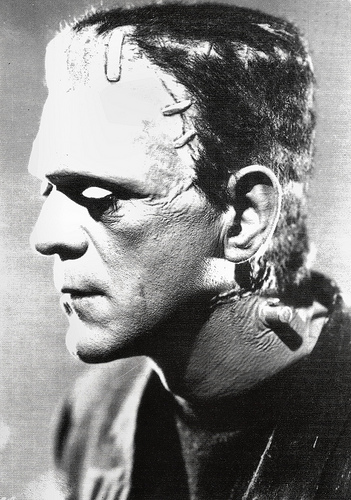
American postcard by Zoetrope Images Ltd., Boston, no 432. Photo: Boris Karloff in Frankenstein (James Whale, 1931).
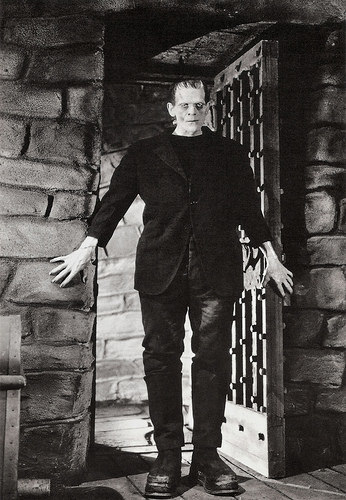
American postcard by Classico San Francisco, no. 233/01. Photo: Universal Pictures. Publicity still for Frankenstein (James Whale, 1931).
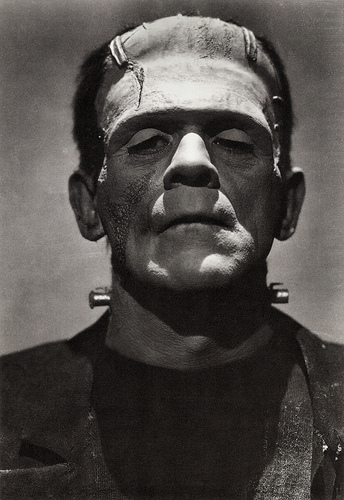
American postcard by Classico San Francisco, no. 233/06. Photo: Universal Pictures. Publicity still for Frankenstein (James Whale, 1931).
A frightening sight to behold
A key film which brought Boris Karloff recognition was The Criminal Code (Howard Hawks, 1931), a prison drama in which he reprised a dramatic part he had played on stage. With his characteristic short-cropped hair and menacing features, Karloff was a frightening sight to behold. Opposite Edward G. Robinson, Karloff played a key supporting part as an unethical newspaper reporter in Five Star Final (Mervyn LeRoy, 1931), a film about tabloid journalism which was nominated for the Oscar for Best Picture.
Karloff's role as Frankenstein's monster in Frankenstein (James Whale, 1931), based on the classic Mary Shelley book, propelled him to stardom. Wikipedia : “The bulky costume with four-inch platform boots made it an arduous role but the costume and extensive makeup produced the classic image. The costume was a job in itself for Karloff with the shoes weighing 11 pounds (5 kg) each.”
The aura of mystery surrounding Karloff was highlighted in the opening credits, as he was listed as simply "?." The film was a commercial and critical success for Universal, and Karloff was instantly established as a hot property in Hollywood. Universal Studios was quick to acquire ownership of the copyright to the makeup format for the Frankenstein monster that Jack P. Pierce had designed.
A year later, Karloff played another iconic character, Imhotep in The Mummy (Karl Freund, 1932). The Old Dark House (James Whale, 1932) with Charles Laughton , and the starring role in MGM’s The Mask of Fu Manchu (Charles Brabin, 1932) quickly followed. Steve Vertlieb at The Thunder Child : “Wonderfully kinky, the film co-starred young Myrna Loy as the intoxicating, yet sadistic Fah Lo See, Fu Manchu's sexually perverse daughter. Filmed prior to Hollywood's infamous production code, the film joyously escaped the later scrutiny of The Hayes Office, and remains a fascinating example of pre-code extravagance.”
These films all confirmed Karloff's new-found stardom. Horror had become his primary genre, and he gave a string of lauded performances in 1930s Universal Horror films. Karloff reprised the role of Frankenstein's monster in two other films, the sensational Bride of Frankenstein (James Whale, 1935) and the less thrilling Son of Frankenstein (Rowland V. Lee, 1939), the latter also featuring Bela Lugosi .
Steve Vertlieb about Bride of Frankenstein: “Whale delivered perhaps the greatest horror film of the decade and easily the most critically acclaimed rendition of Mary Shelley's novel ever released. The Bride of Frankenstein remains a work of sheer genius, a brilliantly conceived and realized take on loneliness, vanity, and madness. The cast of British character actors is simply superb.”
While the long, creative partnership between Karloff and Lugosi never led to a close friendship, it produced some of the actors' most revered and enduring productions, beginning with The Black Cat (Edgar G. Ullmer, 1934). Follow-ups included The Raven (Lew Landers, 1935), the rarely seen, imaginative science fiction melodrama The Invisible Ray (Lambert Hillyer, 1936), and The Body Snatcher (Robert Wise, 1945).
Karloff played a wide variety of roles in other genres besides Horror. He was memorably gunned down in a bowling alley in Howard Hawks' classic Scarface (1932) starring Paul Muni. He played a religious First World War soldier in John Ford’s epic The Lost Patrol (1934) opposite Victor McLaglen .
Between 1938 and 1940, Karloff starred in five films for Monogram Pictures, including Mr. Wong, Detective (William Nigh, 1938). During this period, he also starred with Basil Rathbone in Tower of London (Rowland V. Lee, 1939) as the murderous henchman of King Richard III, and with Margaret Lindsay in British Intelligence (Terry O. Morse, 1940). In 1944, he underwent a spinal operation to relieve his chronic arthritic condition.
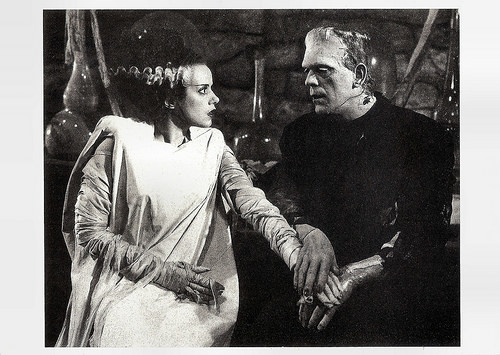
French postcard in the Collection Cinéma by Editions La Malibran, Paris, no. CA 53, 1989. Photo: Boris Karloff and Elsa Lanchester in Bride of Frankenstein (James Whale, 1935).
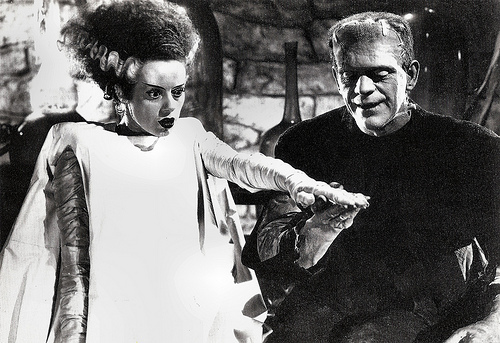
American postcard by Classico San Francisco, no. 233/007. Photo: Universal Pictures. Publicity still for The Bride of Frankenstein (James Whale, 1935) with Boris Karloff and Elsa Lanchester.
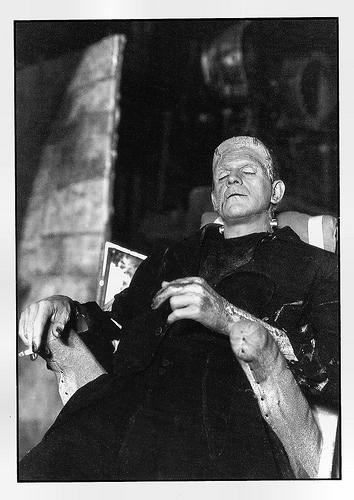
French postcard in the Entr'acte series by Editions aphodèle mâcon, no 001/09. Photo: Boris Karloff relaxing with a cigarette during an interval of the shooting of Bride of Frankenstein (James Whale, 1935).
Bone chilling intensity
Boris Karloff revisited the Frankenstein mythos in several later films, including taking the starring role of the villainous Dr. Niemann in House of Frankenstein (Erle C. Kenton, 1944), in which the monster was played by Glenn Strange. He reprised the role of the ‘mad scientist’ in Frankenstein 1970 (Howard W. Koch, 1958) as Baron Victor von Frankenstein II, the grandson of the original creator. The finale reveals that the crippled Baron has given his own face (i.e., Karloff's) to the monster.
From 1945 to 1946, Boris Karloff appeared in three films for RKO produced by Val Lewton: Isle of the Dead (Mark Robson, 1945), The Body Snatcher (Robert Wise, 1945), and Bedlam (Mark Robson, 1946). Karloff had left Universal because he thought the Frankenstein franchise had run its course.
Karloff was a frequent guest on radio programs. In 1949, he was the host and star of the radio and television anthology series Starring Boris Karloff. In 1950, he had his own weekly children's radio show in New York. He played children's music and told stories and riddles, and attracted many adult listeners as well.
An enthusiastic performer, he returned to the Broadway stage in the original production of Arsenic and Old Lace (1941), in which he played a homicidal gangster enraged to be frequently mistaken for Karloff. In 1962, he reprised the role on television with Tony Randall and Tom Bosley. He also appeared as Captain Hook in the play Peter Pan with Jean Arthur.
In 1955, he returned to the Broadway stage to portray the sympathetic Bishop Cauchon in Jean Anouilh's The Lark. Karloff regarded the production as the highlight of his long career. Julie Harris was his co-star as Joan of Arc in the celebrated play, recreated for live television in 1957 with Karloff, Harris and much of the original New York company intact. For his role, Karloff was nominated for a Tony Award.
Karloff donned the monster make-up for the last time for a Halloween episode of the TV series Route 66 (1962), which also featured Peter Lorre and Lon Chaney, Jr. In the 1960s, Karloff appeared in several films for American International Pictures, including The Comedy of Terrors (Jacques Tourneur, 1963) with Vincent Price and Peter Lorre , The Raven (Roger Corman, 1963), The Terror (Roger Corman, 1963) with Jack Nicholson, and Die, Monster, Die! (Daniel Haller, 1965).
Another project for American International release was the frightening Italian horror classic I tre volti della paura/Black Sabbath (Mario Bava, 1963), in which Karloff played a vampire with bone chilling intensity. He also starred in British cult director Michael Reeves's second feature film, The Sorcerers (1966).
He gained new popularity among a young generation when he narrated the animated TV film Dr. Seuss' How the Grinch Stole Christmas (Chuck Jones, Ben Washam. 1966), and provided the voice of the Grinch. Karloff later received a Grammy Award for Best Recording For Children after the story was released as a record.
Then he starred as a retired horror film actor in Targets (Peter Bogdanovich, 1968). Steve Vertlieb: “Targets was a profoundly disturbing study of a young sniper holding a small Midwestern community, deep in the bible belt, terrifyingly at bay. The celebrated subplot concerned the philosophical dilemma of creating fanciful horrors on the screen, while graphic, troubling reality was eclipsing the superficiality so tiredly repeated by Hollywood. Karloff co-starred, essentially as himself, an aged horror star named Byron Orlok, who wants simply to retire from the imagined horrors of a faded genre, only to come shockingly to grips with the depravity and genuine terror found on America's streets. Bogdanovich's first film as a director won praise from critics and audiences throughout the world community, and won its elder star the best, most respectful notices of his later career.”
In 1968, he played occult expert Professor Marsh in the British production Curse of the Crimson Altar (Vernon Sewell, 1968), which was the last Karloff film to be released during his lifetime. He ended his career by appearing in four low-budget Mexican horror films, which were released posthumously.
While shooting his final films, Karloff suffered from emphysema. Only half of one lung was still functioning and he required oxygen between takes. he contracted bronchitis in 1968 and was hospitalised. Early 1969, he died of pneumonia at the King Edward VII Hospital, Midhurst, in Sussex, at the age of 81. Boris Karloff married five times and had one child, daughter Sara Karloff, by his fourth wife.
Trailer The Mummy (1932). Source: The Mummy (Karl Freund, 1932). (YouTube).
Trailer Bride of Frankenstein (1935). Source: Movieclips (YouTube).
Trailer for I tre volti della paura/Black Sabbath (1963). Source: revokcom (YouTube).
Sources: Steve Vertlieb (The Thunder Child), Wikipedia, and .

British postcard in the Picturegoer series, London, no 707 H. Photo: Universal.

Vintage playing card.

British postcard in the Picturegoer series, London, no W 516. Photo: Universal International.
An exotic Arabian or Indian villain
Boris Karloff was born as William Henry Pratt in 1887 in London, England. Pratt himself stated that he was born in Dulwich, which is nearby London. His parents were Edward John Pratt, Jr. and his third wife Eliza Sarah Millard.
‘Billy’ never knew his father. Edward Pratt had worked for the Indian Salt Revenue Service, and had virtually abandoned his family in far off England. Edward died when his son was still an infant and so Billy was raised by his mother. He was the youngest of nine children, and following his mother's death was brought up by his elder brothers and sisters.
As a child, Billy performed each Christmas in plays staged by St. Mary Magdalene's Church. His first role was that of The Demon King in the pantomime Cinderella. Billy was bow-legged, had a lisp, and stuttered. He conquered his stutter, but not his lisp, which was noticeable throughout his career in the film industry.
After his education at private schools, he attended King's College London where he took studies aimed at a career with the British Government's Consular Service. However, in 1909, the 22-years-old left university without graduating and sailed from Liverpool to Canada, where he worked as a farm labourer and did various odd itinerant jobs.
In Canada, he began appearing in theatrical performances, and chose the stage name Boris Karloff. Later, he claimed he chose ‘Boris’ because it sounded foreign and exotic, and that ‘Karloff’ was a family name. However, his daughter Sara Karloff publicly denied any knowledge of Slavic forebears, Karloff or otherwise.
One reason for the name change was to prevent embarrassment to his family. He did not reunite with his family until he returned to Britain to make The Ghoul (T. Hayes Hunter, 1933), opposite Cedric Hardwicke . Karloff was extremely worried that his family would disapprove of his new, macabre claim to world fame. Instead, his brothers jostled for position around him and happily posed for publicity photographs.
In 1911, Karloff joined the Jeanne Russell Company and later joined the Harry St. Clair Co. that performed in Minot, North Dakota, for a year in an opera house above a hardware store. Whilst he was trying to establish his acting career, Karloff had to perform years of difficult manual labour in Canada and the U.S. in order to make ends meet. He was left with back problems from which he suffered for the rest of his life.
In 1917, he arrived in Hollywood, where he went on to make dozens of silent films. Some of his first roles were in film serials, such as The Masked Rider (Aubrey M. Kennedy, 1919), in Chapter 2 of which he can be glimpsed onscreen for the first time, and The Hope Diamond Mystery (Stuart Paton, 1920). In these early roles, he was often cast as an exotic Arabian or Indian villain.
Other silent films were The Deadlier Sex (Robert Thornby, 1920) with Blanche Sweet, Omar the Tentmaker (James Young, 1922), Dynamite Dan (Bruce Mitchell, 1924) and Tarzan and the Golden Lion (J.P. McGowan, 1927) in which James Pierce played Tarzan. In 1926 Karloff found a provocative role in The Bells (James Young, 1926), in which he played a sinister hypnotist opposite Lionel Barrymore. He worked with Barrymore again in his first sound film, the thriller The Unholy Night (Lionel Barrymore, 1929).

American postcard by Zoetrope Images Ltd., Boston, no 432. Photo: Boris Karloff in Frankenstein (James Whale, 1931).

American postcard by Classico San Francisco, no. 233/01. Photo: Universal Pictures. Publicity still for Frankenstein (James Whale, 1931).

American postcard by Classico San Francisco, no. 233/06. Photo: Universal Pictures. Publicity still for Frankenstein (James Whale, 1931).
A frightening sight to behold
A key film which brought Boris Karloff recognition was The Criminal Code (Howard Hawks, 1931), a prison drama in which he reprised a dramatic part he had played on stage. With his characteristic short-cropped hair and menacing features, Karloff was a frightening sight to behold. Opposite Edward G. Robinson, Karloff played a key supporting part as an unethical newspaper reporter in Five Star Final (Mervyn LeRoy, 1931), a film about tabloid journalism which was nominated for the Oscar for Best Picture.
Karloff's role as Frankenstein's monster in Frankenstein (James Whale, 1931), based on the classic Mary Shelley book, propelled him to stardom. Wikipedia : “The bulky costume with four-inch platform boots made it an arduous role but the costume and extensive makeup produced the classic image. The costume was a job in itself for Karloff with the shoes weighing 11 pounds (5 kg) each.”
The aura of mystery surrounding Karloff was highlighted in the opening credits, as he was listed as simply "?." The film was a commercial and critical success for Universal, and Karloff was instantly established as a hot property in Hollywood. Universal Studios was quick to acquire ownership of the copyright to the makeup format for the Frankenstein monster that Jack P. Pierce had designed.
A year later, Karloff played another iconic character, Imhotep in The Mummy (Karl Freund, 1932). The Old Dark House (James Whale, 1932) with Charles Laughton , and the starring role in MGM’s The Mask of Fu Manchu (Charles Brabin, 1932) quickly followed. Steve Vertlieb at The Thunder Child : “Wonderfully kinky, the film co-starred young Myrna Loy as the intoxicating, yet sadistic Fah Lo See, Fu Manchu's sexually perverse daughter. Filmed prior to Hollywood's infamous production code, the film joyously escaped the later scrutiny of The Hayes Office, and remains a fascinating example of pre-code extravagance.”
These films all confirmed Karloff's new-found stardom. Horror had become his primary genre, and he gave a string of lauded performances in 1930s Universal Horror films. Karloff reprised the role of Frankenstein's monster in two other films, the sensational Bride of Frankenstein (James Whale, 1935) and the less thrilling Son of Frankenstein (Rowland V. Lee, 1939), the latter also featuring Bela Lugosi .
Steve Vertlieb about Bride of Frankenstein: “Whale delivered perhaps the greatest horror film of the decade and easily the most critically acclaimed rendition of Mary Shelley's novel ever released. The Bride of Frankenstein remains a work of sheer genius, a brilliantly conceived and realized take on loneliness, vanity, and madness. The cast of British character actors is simply superb.”
While the long, creative partnership between Karloff and Lugosi never led to a close friendship, it produced some of the actors' most revered and enduring productions, beginning with The Black Cat (Edgar G. Ullmer, 1934). Follow-ups included The Raven (Lew Landers, 1935), the rarely seen, imaginative science fiction melodrama The Invisible Ray (Lambert Hillyer, 1936), and The Body Snatcher (Robert Wise, 1945).
Karloff played a wide variety of roles in other genres besides Horror. He was memorably gunned down in a bowling alley in Howard Hawks' classic Scarface (1932) starring Paul Muni. He played a religious First World War soldier in John Ford’s epic The Lost Patrol (1934) opposite Victor McLaglen .
Between 1938 and 1940, Karloff starred in five films for Monogram Pictures, including Mr. Wong, Detective (William Nigh, 1938). During this period, he also starred with Basil Rathbone in Tower of London (Rowland V. Lee, 1939) as the murderous henchman of King Richard III, and with Margaret Lindsay in British Intelligence (Terry O. Morse, 1940). In 1944, he underwent a spinal operation to relieve his chronic arthritic condition.

French postcard in the Collection Cinéma by Editions La Malibran, Paris, no. CA 53, 1989. Photo: Boris Karloff and Elsa Lanchester in Bride of Frankenstein (James Whale, 1935).

American postcard by Classico San Francisco, no. 233/007. Photo: Universal Pictures. Publicity still for The Bride of Frankenstein (James Whale, 1935) with Boris Karloff and Elsa Lanchester.

French postcard in the Entr'acte series by Editions aphodèle mâcon, no 001/09. Photo: Boris Karloff relaxing with a cigarette during an interval of the shooting of Bride of Frankenstein (James Whale, 1935).
Bone chilling intensity
Boris Karloff revisited the Frankenstein mythos in several later films, including taking the starring role of the villainous Dr. Niemann in House of Frankenstein (Erle C. Kenton, 1944), in which the monster was played by Glenn Strange. He reprised the role of the ‘mad scientist’ in Frankenstein 1970 (Howard W. Koch, 1958) as Baron Victor von Frankenstein II, the grandson of the original creator. The finale reveals that the crippled Baron has given his own face (i.e., Karloff's) to the monster.
From 1945 to 1946, Boris Karloff appeared in three films for RKO produced by Val Lewton: Isle of the Dead (Mark Robson, 1945), The Body Snatcher (Robert Wise, 1945), and Bedlam (Mark Robson, 1946). Karloff had left Universal because he thought the Frankenstein franchise had run its course.
Karloff was a frequent guest on radio programs. In 1949, he was the host and star of the radio and television anthology series Starring Boris Karloff. In 1950, he had his own weekly children's radio show in New York. He played children's music and told stories and riddles, and attracted many adult listeners as well.
An enthusiastic performer, he returned to the Broadway stage in the original production of Arsenic and Old Lace (1941), in which he played a homicidal gangster enraged to be frequently mistaken for Karloff. In 1962, he reprised the role on television with Tony Randall and Tom Bosley. He also appeared as Captain Hook in the play Peter Pan with Jean Arthur.
In 1955, he returned to the Broadway stage to portray the sympathetic Bishop Cauchon in Jean Anouilh's The Lark. Karloff regarded the production as the highlight of his long career. Julie Harris was his co-star as Joan of Arc in the celebrated play, recreated for live television in 1957 with Karloff, Harris and much of the original New York company intact. For his role, Karloff was nominated for a Tony Award.
Karloff donned the monster make-up for the last time for a Halloween episode of the TV series Route 66 (1962), which also featured Peter Lorre and Lon Chaney, Jr. In the 1960s, Karloff appeared in several films for American International Pictures, including The Comedy of Terrors (Jacques Tourneur, 1963) with Vincent Price and Peter Lorre , The Raven (Roger Corman, 1963), The Terror (Roger Corman, 1963) with Jack Nicholson, and Die, Monster, Die! (Daniel Haller, 1965).
Another project for American International release was the frightening Italian horror classic I tre volti della paura/Black Sabbath (Mario Bava, 1963), in which Karloff played a vampire with bone chilling intensity. He also starred in British cult director Michael Reeves's second feature film, The Sorcerers (1966).
He gained new popularity among a young generation when he narrated the animated TV film Dr. Seuss' How the Grinch Stole Christmas (Chuck Jones, Ben Washam. 1966), and provided the voice of the Grinch. Karloff later received a Grammy Award for Best Recording For Children after the story was released as a record.
Then he starred as a retired horror film actor in Targets (Peter Bogdanovich, 1968). Steve Vertlieb: “Targets was a profoundly disturbing study of a young sniper holding a small Midwestern community, deep in the bible belt, terrifyingly at bay. The celebrated subplot concerned the philosophical dilemma of creating fanciful horrors on the screen, while graphic, troubling reality was eclipsing the superficiality so tiredly repeated by Hollywood. Karloff co-starred, essentially as himself, an aged horror star named Byron Orlok, who wants simply to retire from the imagined horrors of a faded genre, only to come shockingly to grips with the depravity and genuine terror found on America's streets. Bogdanovich's first film as a director won praise from critics and audiences throughout the world community, and won its elder star the best, most respectful notices of his later career.”
In 1968, he played occult expert Professor Marsh in the British production Curse of the Crimson Altar (Vernon Sewell, 1968), which was the last Karloff film to be released during his lifetime. He ended his career by appearing in four low-budget Mexican horror films, which were released posthumously.
While shooting his final films, Karloff suffered from emphysema. Only half of one lung was still functioning and he required oxygen between takes. he contracted bronchitis in 1968 and was hospitalised. Early 1969, he died of pneumonia at the King Edward VII Hospital, Midhurst, in Sussex, at the age of 81. Boris Karloff married five times and had one child, daughter Sara Karloff, by his fourth wife.
Trailer The Mummy (1932). Source: The Mummy (Karl Freund, 1932). (YouTube).
Trailer Bride of Frankenstein (1935). Source: Movieclips (YouTube).
Trailer for I tre volti della paura/Black Sabbath (1963). Source: revokcom (YouTube).
Sources: Steve Vertlieb (The Thunder Child), Wikipedia, and .
Published on April 18, 2017 22:00
April 17, 2017
Juliette Binoche
French actress Juliette Binoche (1964) has appeared in more than 60 international films. She won numerous international awards, and has appeared on stage across the world. André Téchiné made her a star in France with the leading role in his drama Rendez-vous (1985). Her sensual performance in The Unbearable Lightness of Being (Philip Kaufman, 1988) launched her international career. Other career highlights are her roles in Three Colors: Blue (Krzysztof Kieślowski, 1993), The English Patient (Anthony Minghella, 1996), for which she won an Oscar, and Caché (Michael Haneke, 2005).
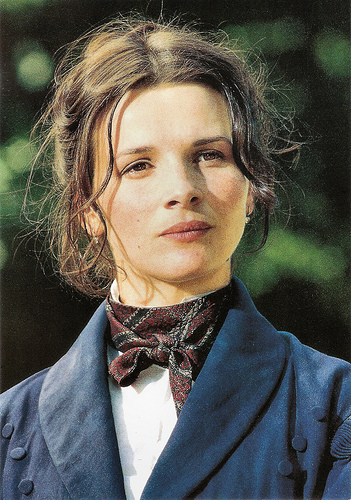
French postcard by CEC Rhone-Alpes. Photo: Mario Tursi. Publicity still for Le hussard sur le toit/The Horseman on the Roof (Jean-Paul Rappeneau, 1995).
The darling of the festival
Juliette Binoche was born in Paris, in 1964. She was the daughter of Jean-Marie Binoche, a director, actor, and sculptor, and Monique Yvette Stalens, a teacher, director, and actress. She is the sister of actress/photographer Marion Stalens. Her parents divorced when she was four, so she grew up living between each parent and a Catholic boarding school.
In her teenage years Juliette began acting at school in stage-productions. At 17 she directed and starred in a student production of the Eugène Ionesco play, Exit the King. She studied acting at the Conservatoire National Supérieur d'Art Dramatique (CNSAD), but quit after a short time as she disliked the curriculum.
In the early 1980s, she found an agent through a friend and joined a theatre troupe, touring France, Belgium and Switzerland under the pseudonym Juliette Adrienne. After performing in several stage productions and a few TV productions, Binoche secured her first feature-film appearance with a minor role in the drama Liberty Belle (Pascal Kané, 1983). Her role required just two days on–set, but was enough to inspire Binoche to pursue a career in film.
In 1983, she auditioned for the female lead in Jean-Luc Godard's' controversial Je vous salue, Marie/Hail Mary (1985), a modern retelling of the Virgin birth. She spent six months on the set of the film in Geneva, although her role in the final cut only contained a few scenes.
She gained more significant exposure in Jacques Doillon's critically acclaimed La Vie de Famille/Family Life (1985), cast as the volatile teenage step-daughter of Samy Frey 's central character. Director André Téchiné made her a star in France with the leading role in his provocative erotic drama Rendez-vous (1985). The film, co-starring Lambert Wilson and Jean-Louis Trintignant , premiered at the 1985 Cannes Film Festival, winning Best Director.
Rendez-vous was a sensation and Binoche became the darling of the festival. In 1986, Binoche was nominated for her first César for Best Actress in a Leading Role for her performance. She starred opposite Michel Piccoli in the avant-garde thriller Mauvais Sang/Bad Blood (Leos Carax, 1986). Binoche plays Anna the vastly younger lover of Marc (Piccoli) who falls in love with Alex (Denis Lavant), a young thief. Mauvais Sang was a critical and commercial success, leading to Binoche's second César nomination.
She gave a sensual performance opposite Daniel Day-Lewis in The Unbearable Lightness of Being (Philip Kaufman, 1988), the adaptation of Milan Kundera's novel. It was Binoche's first English language role and was a worldwide success with critics and audiences alike.
In the summer of 1988, Binoche returned to the stage in an acclaimed production of Anton Chekhov's The Seagull directed by Russian director Andrei Konchalovsky at Théâtre De L'Odéon in Paris. Later that year she began work on Léos Carax's Les Amants du Pont-Neuf. The film was beset by problems and took three years to complete, requiring investment from three producers and funds from the French government. When finally released in 1991, Les Amants du Pont-Neuf was a critical success. Binoche won a European Film Award and her third César nomination for her performance.
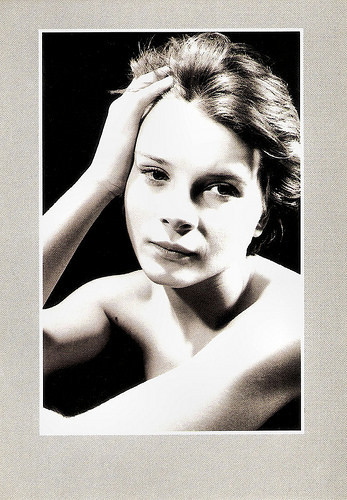
French postcard in the Le jour se lève series by Editions Humour à la carte, Paris, no. ST-170. Photo: Jean-Pierre Larcher.
The most expensive film in the history of French cinema
Juliette Binoche chose to pursue an international career outside France. Binoche relocated to London for the Emily Bronte adaptation Wuthering Heights (Peter Kosminsky, 1992) with Ralph Fiennes as Heathcliff, and Damage (Louis Malle, 1992) with Jeremy Irons, both enhanced her international reputation. For her performance in Damage, Binoche received her fourth César nomination.
She sparked the interest of Steven Spielberg, who offered her roles in three films: Indiana Jones and the Last Crusade (1989), Jurassic Park (1993), and Schindler's List (1993). which she declined.
Instead, she chose for Trois couleurs : Bleu/Three Colors: Blue (Krzysztof Kieślowski, 1993), for which she won the Venice Film Festival Award for Best Actress and a César. The first film in a trilogy inspired by the ideals of the French republic and the colors of its flag, Three Colors: Blue is the story of a young woman who loses her composer husband and daughter in a car accident. Though devastated she learns to cope by rejecting her previous life by rejecting all people, belongings and emotions. Binoche made cameo appearances in the other two films in Krzysztof Kieślowski's trilogy, Trois couleurs : Blanc/Three Colors: White (1994) and Trois couleurs : Rouge/Three Colors: Red (1994).
Binoche took a short sabbatical during which she gave birth to her son Raphaël in September 1993. In 1995, she returned to the screen in a big-budget adaptation of Jean Giono's Le hussard sur le toit/The Horseman on the Roof (Jean-Paul Rappeneau, 1995) with Olivier Martinez. At the time, it was the most expensive film in the history of French cinema. The film was a box-office success around the world and Binoche was again nominated for a César for Best Actress.
She gained further acclaim in The English Patient (Anthony Minghella, 1996), for which she was awarded an Academy Award and a BAFTA for Best Supporting Actress in addition to the Best Actress Award at the 1997 Berlin International Film Festival. Binoche was reunited with director André Téchiné for Alice et Martin (1998), the story of a relationship between an emotionally damaged Parisian musician and her younger lover (Alexis Loret) who hides a dark family secret.
Juliette Binoche appeared on stage in a 1998 London production of Luigi Pirandello's Clothe the Naked retitled Naked and in a 2000 production of Harold Pinter's Betrayal on Broadway for which she was nominated for a Tony Award. Between 1995 and 2000, she was also the advertising face of the Lancôme perfume Poème.
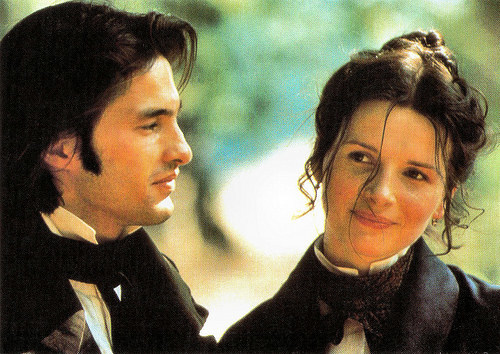
Danish postcard by Go Card, no. 2194, 1996. Photo: Camera Film. Publicity still for Le hussard sur le toit/The Horseman on the Roof (Jean-Paul Rappeneau, 1995) with Olivier Martinez.
A welcome change from playing the romantic heroine
Juliette Binoche was nominated for an Academy Award for Best Actress for her performance opposite Johnny Depp in the romantic comedy Chocolat (Lasse Hallström, 2000).
Another hit was the period drama La Veuve de Saint-Pierre (Patrice Leconte, 2000), for which she was nominated for a César for Best Actress. Opposite Daniel Auteuil she played the role of a woman who attempts to save a condemned man from the guillotine. The film won favourable reviews, and was nominated for a Golden Globe for Best Foreign Language Film.
Next she appeared in Code inconnu: Récit incomplet de divers voyages/Code Unknown (Michael Haneke, 2000), a film which was made following Binoche's approach to the Austrian director. Her critically acclaimed role was a welcome change from playing the romantic heroine in a series of costume dramas.
During the following decade, she maintained a successful career, alternating between French and English language roles in both mainstream and art-house productions. 'La Binoche' appeared in such films as Jet Lag (Daniele Thompson, 2002) opposite Jean Reno , Caché (Michael Haneke, 2005), and Breaking and Entering (Anthony Minghella, 2006) with Jude Law.
Flight of the Red Balloon (Hou Hsiao-Hsien, 2007) pays homage to Albert Lamorisse's 1957 short The Red Balloon. The film tells the story of a woman's efforts to juggle her responsibilities as a single mother with her commitment to her career as a voice artist. Shot on location in Paris, the film was entirely improvised by the cast.
In 2008 Binoche began a world tour with a modern dance production titled in-i, co-created in collaboration with Akram Khan. In 2010, she won the Best Actress Award at the Cannes Film Festival for her role in Abbas Kiarostami's Certified Copy (2010) making her the first actress to win the European ‘Best Actress Triple Crown’ for winning best actress award at the Berlin, Cannes and Venice film festivals.
Her later films include Cosmopolis (David Cronenberg, 2011) with Robert Pattinson, Camille Claudel 1915 (Bruno Dumont, 2013) and Clouds of Sils Maria (Olivier Assayas, 2014). In 2015, Binoche starred on stage in a new English language translation of Antigone, directed by Ivo van Hove.
Juliette Binoche has two children: a son Raphaël (1993), whose father is André Halle, a professional scuba diver, and a daughter Hana (1999), whose father is actor Benoît Magimel, with whom Binoche starred in Les Enfants du Siècle/Children of the Century (Diane Kurys, 1999).
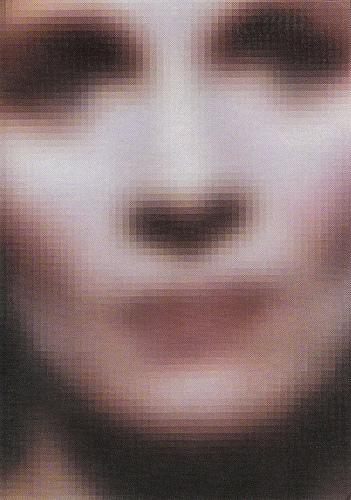
Hungarian postcard by Montazs 2000. Photo: publicity still for Code inconnu Récit incomplet de divers voyages (Michael Haneke, 2004).
Sources: (IMDb), Wikipedia, and.

French postcard by CEC Rhone-Alpes. Photo: Mario Tursi. Publicity still for Le hussard sur le toit/The Horseman on the Roof (Jean-Paul Rappeneau, 1995).
The darling of the festival
Juliette Binoche was born in Paris, in 1964. She was the daughter of Jean-Marie Binoche, a director, actor, and sculptor, and Monique Yvette Stalens, a teacher, director, and actress. She is the sister of actress/photographer Marion Stalens. Her parents divorced when she was four, so she grew up living between each parent and a Catholic boarding school.
In her teenage years Juliette began acting at school in stage-productions. At 17 she directed and starred in a student production of the Eugène Ionesco play, Exit the King. She studied acting at the Conservatoire National Supérieur d'Art Dramatique (CNSAD), but quit after a short time as she disliked the curriculum.
In the early 1980s, she found an agent through a friend and joined a theatre troupe, touring France, Belgium and Switzerland under the pseudonym Juliette Adrienne. After performing in several stage productions and a few TV productions, Binoche secured her first feature-film appearance with a minor role in the drama Liberty Belle (Pascal Kané, 1983). Her role required just two days on–set, but was enough to inspire Binoche to pursue a career in film.
In 1983, she auditioned for the female lead in Jean-Luc Godard's' controversial Je vous salue, Marie/Hail Mary (1985), a modern retelling of the Virgin birth. She spent six months on the set of the film in Geneva, although her role in the final cut only contained a few scenes.
She gained more significant exposure in Jacques Doillon's critically acclaimed La Vie de Famille/Family Life (1985), cast as the volatile teenage step-daughter of Samy Frey 's central character. Director André Téchiné made her a star in France with the leading role in his provocative erotic drama Rendez-vous (1985). The film, co-starring Lambert Wilson and Jean-Louis Trintignant , premiered at the 1985 Cannes Film Festival, winning Best Director.
Rendez-vous was a sensation and Binoche became the darling of the festival. In 1986, Binoche was nominated for her first César for Best Actress in a Leading Role for her performance. She starred opposite Michel Piccoli in the avant-garde thriller Mauvais Sang/Bad Blood (Leos Carax, 1986). Binoche plays Anna the vastly younger lover of Marc (Piccoli) who falls in love with Alex (Denis Lavant), a young thief. Mauvais Sang was a critical and commercial success, leading to Binoche's second César nomination.
She gave a sensual performance opposite Daniel Day-Lewis in The Unbearable Lightness of Being (Philip Kaufman, 1988), the adaptation of Milan Kundera's novel. It was Binoche's first English language role and was a worldwide success with critics and audiences alike.
In the summer of 1988, Binoche returned to the stage in an acclaimed production of Anton Chekhov's The Seagull directed by Russian director Andrei Konchalovsky at Théâtre De L'Odéon in Paris. Later that year she began work on Léos Carax's Les Amants du Pont-Neuf. The film was beset by problems and took three years to complete, requiring investment from three producers and funds from the French government. When finally released in 1991, Les Amants du Pont-Neuf was a critical success. Binoche won a European Film Award and her third César nomination for her performance.

French postcard in the Le jour se lève series by Editions Humour à la carte, Paris, no. ST-170. Photo: Jean-Pierre Larcher.
The most expensive film in the history of French cinema
Juliette Binoche chose to pursue an international career outside France. Binoche relocated to London for the Emily Bronte adaptation Wuthering Heights (Peter Kosminsky, 1992) with Ralph Fiennes as Heathcliff, and Damage (Louis Malle, 1992) with Jeremy Irons, both enhanced her international reputation. For her performance in Damage, Binoche received her fourth César nomination.
She sparked the interest of Steven Spielberg, who offered her roles in three films: Indiana Jones and the Last Crusade (1989), Jurassic Park (1993), and Schindler's List (1993). which she declined.
Instead, she chose for Trois couleurs : Bleu/Three Colors: Blue (Krzysztof Kieślowski, 1993), for which she won the Venice Film Festival Award for Best Actress and a César. The first film in a trilogy inspired by the ideals of the French republic and the colors of its flag, Three Colors: Blue is the story of a young woman who loses her composer husband and daughter in a car accident. Though devastated she learns to cope by rejecting her previous life by rejecting all people, belongings and emotions. Binoche made cameo appearances in the other two films in Krzysztof Kieślowski's trilogy, Trois couleurs : Blanc/Three Colors: White (1994) and Trois couleurs : Rouge/Three Colors: Red (1994).
Binoche took a short sabbatical during which she gave birth to her son Raphaël in September 1993. In 1995, she returned to the screen in a big-budget adaptation of Jean Giono's Le hussard sur le toit/The Horseman on the Roof (Jean-Paul Rappeneau, 1995) with Olivier Martinez. At the time, it was the most expensive film in the history of French cinema. The film was a box-office success around the world and Binoche was again nominated for a César for Best Actress.
She gained further acclaim in The English Patient (Anthony Minghella, 1996), for which she was awarded an Academy Award and a BAFTA for Best Supporting Actress in addition to the Best Actress Award at the 1997 Berlin International Film Festival. Binoche was reunited with director André Téchiné for Alice et Martin (1998), the story of a relationship between an emotionally damaged Parisian musician and her younger lover (Alexis Loret) who hides a dark family secret.
Juliette Binoche appeared on stage in a 1998 London production of Luigi Pirandello's Clothe the Naked retitled Naked and in a 2000 production of Harold Pinter's Betrayal on Broadway for which she was nominated for a Tony Award. Between 1995 and 2000, she was also the advertising face of the Lancôme perfume Poème.

Danish postcard by Go Card, no. 2194, 1996. Photo: Camera Film. Publicity still for Le hussard sur le toit/The Horseman on the Roof (Jean-Paul Rappeneau, 1995) with Olivier Martinez.
A welcome change from playing the romantic heroine
Juliette Binoche was nominated for an Academy Award for Best Actress for her performance opposite Johnny Depp in the romantic comedy Chocolat (Lasse Hallström, 2000).
Another hit was the period drama La Veuve de Saint-Pierre (Patrice Leconte, 2000), for which she was nominated for a César for Best Actress. Opposite Daniel Auteuil she played the role of a woman who attempts to save a condemned man from the guillotine. The film won favourable reviews, and was nominated for a Golden Globe for Best Foreign Language Film.
Next she appeared in Code inconnu: Récit incomplet de divers voyages/Code Unknown (Michael Haneke, 2000), a film which was made following Binoche's approach to the Austrian director. Her critically acclaimed role was a welcome change from playing the romantic heroine in a series of costume dramas.
During the following decade, she maintained a successful career, alternating between French and English language roles in both mainstream and art-house productions. 'La Binoche' appeared in such films as Jet Lag (Daniele Thompson, 2002) opposite Jean Reno , Caché (Michael Haneke, 2005), and Breaking and Entering (Anthony Minghella, 2006) with Jude Law.
Flight of the Red Balloon (Hou Hsiao-Hsien, 2007) pays homage to Albert Lamorisse's 1957 short The Red Balloon. The film tells the story of a woman's efforts to juggle her responsibilities as a single mother with her commitment to her career as a voice artist. Shot on location in Paris, the film was entirely improvised by the cast.
In 2008 Binoche began a world tour with a modern dance production titled in-i, co-created in collaboration with Akram Khan. In 2010, she won the Best Actress Award at the Cannes Film Festival for her role in Abbas Kiarostami's Certified Copy (2010) making her the first actress to win the European ‘Best Actress Triple Crown’ for winning best actress award at the Berlin, Cannes and Venice film festivals.
Her later films include Cosmopolis (David Cronenberg, 2011) with Robert Pattinson, Camille Claudel 1915 (Bruno Dumont, 2013) and Clouds of Sils Maria (Olivier Assayas, 2014). In 2015, Binoche starred on stage in a new English language translation of Antigone, directed by Ivo van Hove.
Juliette Binoche has two children: a son Raphaël (1993), whose father is André Halle, a professional scuba diver, and a daughter Hana (1999), whose father is actor Benoît Magimel, with whom Binoche starred in Les Enfants du Siècle/Children of the Century (Diane Kurys, 1999).

Hungarian postcard by Montazs 2000. Photo: publicity still for Code inconnu Récit incomplet de divers voyages (Michael Haneke, 2004).
Sources: (IMDb), Wikipedia, and.
Published on April 17, 2017 22:00
April 16, 2017
Oliver Tobias
Dashingly handsome Oliver Tobias (1947) was born in Switzerland but started his career in the original London production of Hair (1968), playing the prime rebel role of Berger. He is also known for the title roles in the popular TV series Arthur of the Britons (1972-1973) and the soft-core flick The Stud (1978) opposite Joan Collins. In the following decades, he continued to work as a stage, TV and film actor and director in Great Britain as well as in Germany and Switzerland.
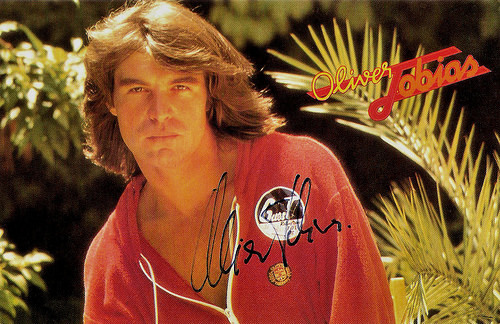
German promotion card by Aladin / EMI Electrola, no. DrWa3193. Photo: Hellemann / Bravo. The card promotes the single I Love You Tomorrow/Dearest Old Friend.
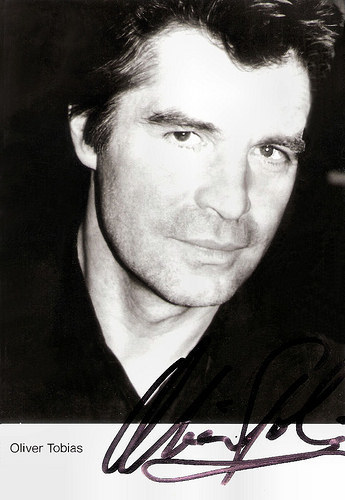
German autograph card by Franz Josef Rüdel, Filmpostkartenverlag, Hamburg. Photo: Ina Berneis.
Hair
Oliver Tobias was born in 1947 as Oliver Tobias Freitag in Leimbach, a village near Zürich in Switzerland. He is the son of the Austrian-Swiss actor Robert Freitag and the German actress Maria Becker. He had two brothers, Christopher and Benedict. Benedict Freitag also became an actor. Christopher committed suicide at the age of 20.
After the divorce of his parents, 8-years-old Oliver went with his mother to the United Kingdom and later trained at East 15 Acting School, an off-spring of Joan Littlewoods Theatre Workshop in London. During his holidays he studied dance at the Ecole de Dance in Zürich.
In 1968, he appeared in the original London production of Hair, playing the prime rebel role of Berger. The following year, he starred in, directed, and choreographed the rock opera in Amsterdam and, in 1970, he directed a production in Tel Aviv. Oliver continued his counterculture musical career with the role of Judas in a German production of Jesus Christ Superstar.
Tobias's film debut was in the French-Italian-Yugoslav adventure film Romansa konjokradice/Romance of a Horsethief (Abraham Polonsky, 1971), co-starring with Yul Brynner , Serge Gainsbourg and Eli Wallach. He then co-starred with Charlotte Rampling and Fabio Testi in the Italian film Addio fratello crudele (Giuseppe Patroni Griffi, 1971), based on the Jacobean tragedy 'Tis Pity She's a Whore by John Ford.
He became popular as Arthur in the TV series Arthur of the Britons (Sidney Hayers a.o., 1972-1973). He returned in the role in the feature film King Arthur, the Young Warlord (Sidney Hayers, Pat Jackson 1975). Gary Brumburgh at IMDb : “A remote and rather prevailing sullenness has only enhanced the mystique and charisma found in dashingly handsome Oliver Tobias.”
Peter Weir directed him in the TV series Luke's Kingdom (Peter Weir, 1976), set in colonial Australia. In 1978, he co-starred with Joan Collins in The Stud (Quentin Masters, 1978), based on the 1969 novel of the same name by Collins' younger sister Jackie Collins. Tobias later claimed that his typecasting in the film as an amorous waiter who sleeps his way to the top ruined his career, while the box-office success of the film helped Joan Collins to restart her career.
Tobias then starred as Prince Hasan in Arabian Adventure (Kevin Connor, 1979), starring Christopher Lee . He also co-starred with David Niven and Richard Jordan in the heist film A Nightingale Sang in Berkeley Square (Ralph Thomas, 1979).

German autograph card by Franz Josef Rüdel, Filmpostkartenverlag, Hamburg. Photo: Ina Berneis.
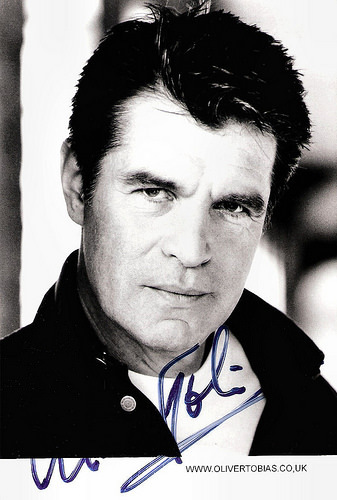
British autograph card by www.olivertobias.co.uk..
Mata Hari
In 1981, Oliver Tobias starred in the British television series Dick Turpin's Greatest Adventure, where he played the character Noll Bridger, a Colonial North American. He also starred in the children's drama series Smuggler (1981), set in Cornwall in 1801. He appeared as The Devil in the video for Ultravox's 1982 hit Hymn.
His films included the British drama The Wicked Lady (Michael Winner, 1983), a remake of the popular 1945 Gainsborough melodrama of the same name. The film received a Razzie Award nomination for Faye Dunaway as Worst Actress. He was also part of the cast of the soft-porn biopic Mata Hari (Curtis Harrington, 1985) which focused more on the disrobing of its star Sylvia Kristel than anything else.
In Austria he starred as Johann Strauss - Der König ohne Krone/Johann Strauss: The King Without a Crown (Franz Antel, 1987) with Mathieu Carrière and Karin Dor . He did not give up his musical roots, showing his prowess in the title role of the rock opera Peer Gynt in Zurich, and in the role of The Pirate King in The Pirates of Penzance at London's Drury Lane Theatre.
As a stretch he also appeared as Bassa Selim at London’s Royal Opera House Covent Garden in the W.A. Mozart opera The Abduction from the Seraglio in 1988 and 1989. Then he acted in a non-musical, the powerful AIDS drama The Normal Heart.
Tobias starred alongside Charles Gray in the Science Fiction film Firestar - First Contact (David Kent-Watson, 1991), at the side of Ernest Borgnine in the Italian actioner L'ultima meta/The Last Match (Fabrizio De Angelis, 1991) and in the Swedish thriller Vendetta (Mikael Håfström, 1995), starring Stefan Sauk.
A year later, Tobias played Rebecque, an aide to the Prince of Orange (Paul Bettany), in the TV drama Sharpe's Waterloo (Tom Clegg, 1996). He also acted in the Irish comedy The Brylcreem Boys (Terence Ryan, 1998), starring Bill Campbell and Gabriel Byrne. In 2000, he returned to the West End in the musical La Cava.
Three years later, he portrayed Percival Brown in the 50th-anniversary production of The Boy Friend and the next year toured in the rock musical Footloose. He has been acting in a variety of roles for German and Swiss TV and also worked on stage in Italy. Tobias also directs such plays as An Airfield in England (2005), produced at Lasham Airfield, England, and Ritter von Miracle by Lopez de Vega which was produced in the castle of Berlechingen in Germany. His brother Benedict played the leading role of Luzman.
His most recent film is the British war comedy Dad's Army (Oliver Parker, 2016), based on the classic BBC television sitcom Dad's Army. Catherine Zeta-Jones plays an elegant journalist, who is sent to report on the Walmington-on-Sea Home Guard platoon. This is all before MI5 discovers that there is a German spy hiding in the fictional British town. The film received generally negative reviews from critics, though Toby Jones' performance as Captain Mainwaring was praised.
Oliver Tobias is divorced from Camilla Ravenshear, with whom he had two daughters, Angelika and Celeste. In 2001, he married Polish-born model Arabella Zamoyska, who is 27 years younger. They have two boys, Luke and Felix, and live in London.
German trailer for Arthur of the Britons (1972-1973). Source: Arild Rafalzik (YouTube).
Trailer The Stud (1978). Source: Umbrella Entertainment (YouTube).
Sources: (IMDb), OliverTobias.co.uk, Wikipedia and .

German promotion card by Aladin / EMI Electrola, no. DrWa3193. Photo: Hellemann / Bravo. The card promotes the single I Love You Tomorrow/Dearest Old Friend.

German autograph card by Franz Josef Rüdel, Filmpostkartenverlag, Hamburg. Photo: Ina Berneis.
Hair
Oliver Tobias was born in 1947 as Oliver Tobias Freitag in Leimbach, a village near Zürich in Switzerland. He is the son of the Austrian-Swiss actor Robert Freitag and the German actress Maria Becker. He had two brothers, Christopher and Benedict. Benedict Freitag also became an actor. Christopher committed suicide at the age of 20.
After the divorce of his parents, 8-years-old Oliver went with his mother to the United Kingdom and later trained at East 15 Acting School, an off-spring of Joan Littlewoods Theatre Workshop in London. During his holidays he studied dance at the Ecole de Dance in Zürich.
In 1968, he appeared in the original London production of Hair, playing the prime rebel role of Berger. The following year, he starred in, directed, and choreographed the rock opera in Amsterdam and, in 1970, he directed a production in Tel Aviv. Oliver continued his counterculture musical career with the role of Judas in a German production of Jesus Christ Superstar.
Tobias's film debut was in the French-Italian-Yugoslav adventure film Romansa konjokradice/Romance of a Horsethief (Abraham Polonsky, 1971), co-starring with Yul Brynner , Serge Gainsbourg and Eli Wallach. He then co-starred with Charlotte Rampling and Fabio Testi in the Italian film Addio fratello crudele (Giuseppe Patroni Griffi, 1971), based on the Jacobean tragedy 'Tis Pity She's a Whore by John Ford.
He became popular as Arthur in the TV series Arthur of the Britons (Sidney Hayers a.o., 1972-1973). He returned in the role in the feature film King Arthur, the Young Warlord (Sidney Hayers, Pat Jackson 1975). Gary Brumburgh at IMDb : “A remote and rather prevailing sullenness has only enhanced the mystique and charisma found in dashingly handsome Oliver Tobias.”
Peter Weir directed him in the TV series Luke's Kingdom (Peter Weir, 1976), set in colonial Australia. In 1978, he co-starred with Joan Collins in The Stud (Quentin Masters, 1978), based on the 1969 novel of the same name by Collins' younger sister Jackie Collins. Tobias later claimed that his typecasting in the film as an amorous waiter who sleeps his way to the top ruined his career, while the box-office success of the film helped Joan Collins to restart her career.
Tobias then starred as Prince Hasan in Arabian Adventure (Kevin Connor, 1979), starring Christopher Lee . He also co-starred with David Niven and Richard Jordan in the heist film A Nightingale Sang in Berkeley Square (Ralph Thomas, 1979).

German autograph card by Franz Josef Rüdel, Filmpostkartenverlag, Hamburg. Photo: Ina Berneis.

British autograph card by www.olivertobias.co.uk..
Mata Hari
In 1981, Oliver Tobias starred in the British television series Dick Turpin's Greatest Adventure, where he played the character Noll Bridger, a Colonial North American. He also starred in the children's drama series Smuggler (1981), set in Cornwall in 1801. He appeared as The Devil in the video for Ultravox's 1982 hit Hymn.
His films included the British drama The Wicked Lady (Michael Winner, 1983), a remake of the popular 1945 Gainsborough melodrama of the same name. The film received a Razzie Award nomination for Faye Dunaway as Worst Actress. He was also part of the cast of the soft-porn biopic Mata Hari (Curtis Harrington, 1985) which focused more on the disrobing of its star Sylvia Kristel than anything else.
In Austria he starred as Johann Strauss - Der König ohne Krone/Johann Strauss: The King Without a Crown (Franz Antel, 1987) with Mathieu Carrière and Karin Dor . He did not give up his musical roots, showing his prowess in the title role of the rock opera Peer Gynt in Zurich, and in the role of The Pirate King in The Pirates of Penzance at London's Drury Lane Theatre.
As a stretch he also appeared as Bassa Selim at London’s Royal Opera House Covent Garden in the W.A. Mozart opera The Abduction from the Seraglio in 1988 and 1989. Then he acted in a non-musical, the powerful AIDS drama The Normal Heart.
Tobias starred alongside Charles Gray in the Science Fiction film Firestar - First Contact (David Kent-Watson, 1991), at the side of Ernest Borgnine in the Italian actioner L'ultima meta/The Last Match (Fabrizio De Angelis, 1991) and in the Swedish thriller Vendetta (Mikael Håfström, 1995), starring Stefan Sauk.
A year later, Tobias played Rebecque, an aide to the Prince of Orange (Paul Bettany), in the TV drama Sharpe's Waterloo (Tom Clegg, 1996). He also acted in the Irish comedy The Brylcreem Boys (Terence Ryan, 1998), starring Bill Campbell and Gabriel Byrne. In 2000, he returned to the West End in the musical La Cava.
Three years later, he portrayed Percival Brown in the 50th-anniversary production of The Boy Friend and the next year toured in the rock musical Footloose. He has been acting in a variety of roles for German and Swiss TV and also worked on stage in Italy. Tobias also directs such plays as An Airfield in England (2005), produced at Lasham Airfield, England, and Ritter von Miracle by Lopez de Vega which was produced in the castle of Berlechingen in Germany. His brother Benedict played the leading role of Luzman.
His most recent film is the British war comedy Dad's Army (Oliver Parker, 2016), based on the classic BBC television sitcom Dad's Army. Catherine Zeta-Jones plays an elegant journalist, who is sent to report on the Walmington-on-Sea Home Guard platoon. This is all before MI5 discovers that there is a German spy hiding in the fictional British town. The film received generally negative reviews from critics, though Toby Jones' performance as Captain Mainwaring was praised.
Oliver Tobias is divorced from Camilla Ravenshear, with whom he had two daughters, Angelika and Celeste. In 2001, he married Polish-born model Arabella Zamoyska, who is 27 years younger. They have two boys, Luke and Felix, and live in London.
German trailer for Arthur of the Britons (1972-1973). Source: Arild Rafalzik (YouTube).
Trailer The Stud (1978). Source: Umbrella Entertainment (YouTube).
Sources: (IMDb), OliverTobias.co.uk, Wikipedia and .
Published on April 16, 2017 22:00
April 15, 2017
Imported from the USA: Janet Gaynor
Petite Janet Gaynor (1906-1984) was the innocent-eyed, round-faced Hollywood star who won the first Academy Award for Best Actress for her roles in three silent films. She went on to become a leading performer in talking pictures, and was one of the most popular Hollywood leading ladies in the 1920s and 1930s. She and Charles Farrell were 'America's favorite love-birds'. By 1934 she was receiving a yearly salary of $252,583 from Fox, making her Hollywood's most highly paid actress.
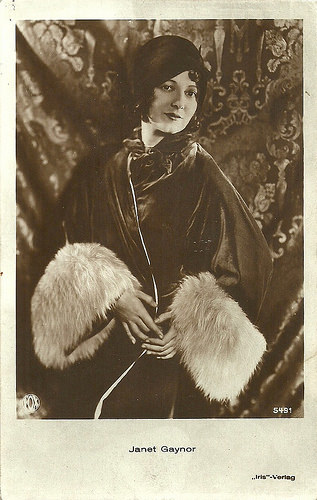
Austrian postcard by Iris Verlag, no. 5491. Photo: Fox.
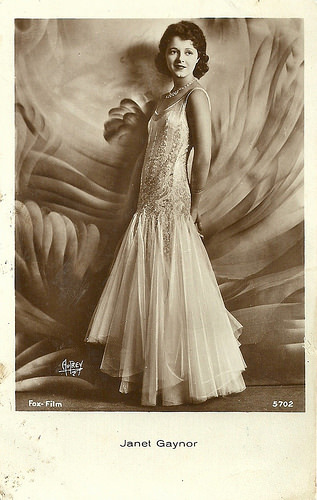
Austrian postcard by Iris Verlag, no. 5702. Photo: Charles Munn Autrey / Fox-Film.
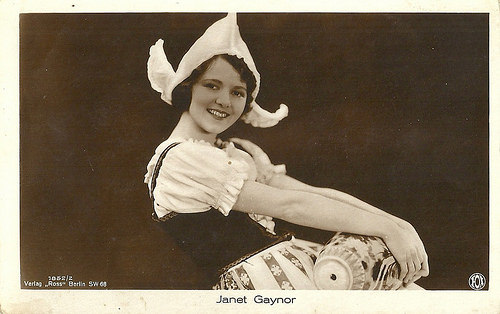
German postcard by Ross Verlag, no. 1852/2, 1927-1928. Photo: Fox. Janet Gaynor as Dutch farmer girl, 'Volendammer' style.
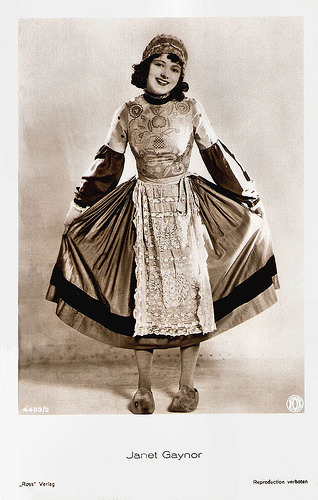
German postcard by Ross Verlag no. 4403/2, 1929-1930. Photo: Fox. Publicity still for Christina (William K. Howard, 1929).
Murnau
Janet Gaynor was born Laura Gainor in 1906, in Philadelphia. Her family moved to Chicago and to Hollywood, where her stepfather was determined that she become a star. She made the rounds of the studios and eventually found work as an extra.
She got her start in films through her sister, a secretary for producer Hal Roach. Gaynor later boasted that she "never had an acting lesson in my life". Universal gave her a contract and she appeared in such shorts as The Gunless Bad Man (William Wyler, 1926) and Don't Shoot (William Wyler, 1926).
Fox executives noticed her and called her in for a test for the second lead in The Johnstown Flood (Irving Cummings, 1926) with George O’ Brien. After the test, the 18-years-old was signed to a five-year contract. She worked with John Ford on The Shamrock Handicap (1926) and The Blue Eagle (1926), again opposite George O’Brien.
Seventh Heaven (Frank Borzage, 1927), in which she played Diane, a Montmartre waif who is rescued from hardship and cruelty by Charles Farrell, made her a star. In 1928 the Oscars were first presented, and Gaynor was named best actress. The award was for her roles in three films - Seventh Heaven (1927), Sunrise (F. W. Murnau, 1927), and Street Angel (Frank Borzage, 1928). This was the first and only time an actress won the Oscar for multiple roles.
Gaynor again worked with Friedrich Wilhelm Murnau on the circus drama 4 Devils (F.W. Murnau, 1928) and with Farrell and Borzage on Lucky Star (Frank Borzage, 1929). She was teamed with Charles Farrell in 11 films altogether as she went from "the World's Sweetheart" to "America's favorite love-birds".
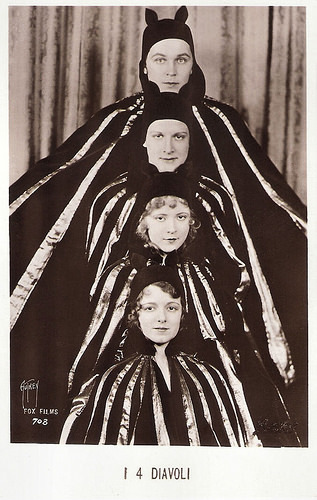
Italian postcard by G.B. Falci Editore, Milano, no. 708. Photo: Charles Munn Autrey / Fox. Publcity still for 4 Devils (Friedrich Wilhelm Murnau, 1928). 4 Devils is one of the most famous 'lost' films.
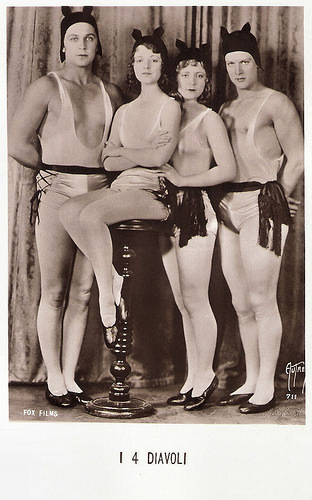
Italian postcard by G.B. Falci Editore, Milano, no. 711. Photo: Charles Munn Autrey / Fox. Publcity still for 4 Devils (Friedrich Wilhelm Murnau, 1928), with Charles Morton, Janet Gaynor, Nancy Drexel and Barry Norton.
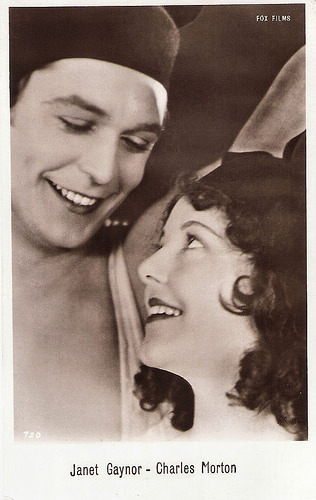
Italian postcard by G.B. Falci Editore, Milano, no. 720. Photo: Charles Munn Autrey / Fox. Publcity still for 4 Devils (Friedrich Wilhelm Murnau, 1928), with Charles Morton
A Star Is Born
Janet Gaynor switched easily to the new talking pictures as her voice translated well to sound. In 12 successive years she made 36 films for Fox, including Daddy Longlegs (Alfred Santell, 1931), Tess of the Storm Country (Alfred Santell, 1932), State Fair (Henry King, 1933), and The Farmer Takes a Wife (Victor Fleming, 1935).
But Gaynor eventually tired of being typecast in the endless comedies and musicals that exploited her special qualities of innocence, vulnerability and sweetness. In 1937, she left Fox to join David O. Selznick and make A Star Is Born (William A. Wellman, 1938) with Fredric March in the classic story of two married film stars, one on the way up and the other on the way down. It was to be one of her most memorable films, and she was nominated for another Academy Award.
Denny Jackson at IMDb : “She was very convincing as Vicki Lester (aka Esther Blodgett), struggling actress trying for the big time. Told by the receptionist at Central casting ‘You know what your chances are? One in a hundred thousand,’ Esther/Vicki replies, ‘But maybe--I'm that one’”
Gaynor was very quiet about her personal life and valued her privacy. In 1932, she had married lawyer Lydell Peck, but they were divorced in 1934. After appearing in The Young in Heart (1938), Gaynor announced that she was retiring from acting. She was 33 and at the peak of her career.
In 1939, she married famous MGM costume designer Gilbert Adrian, known by the single name Adrian. The following year, they had a son, Robin Gaynor Adrian. Her husband died in 1959, and she married producer Paul Gregory in 1964. After she left full-time acting, Gaynor spent much of her time painting; she had several one-woman shows of her work at galleries in Palm Springs, Chicago and New York. Mostly she painted plants and flowers.
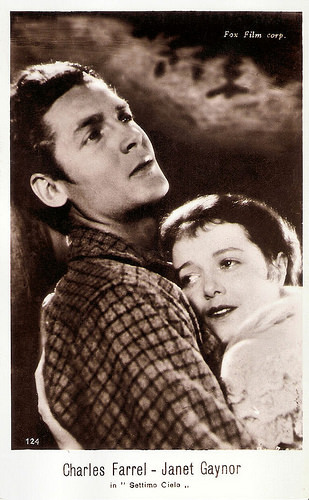
Italian postcard offered by Cioccolata Lurati, no. 124. Photo: Fox. Publicity still for Seventh Heaven (Frank Borzage, 1927) with Charles Farrell.
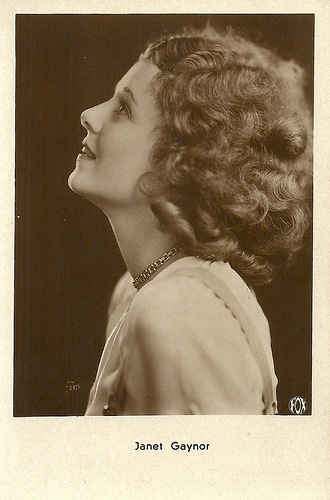
Italian postcard. Imprint on back: Ballerini & Fratini, Florence, no. 125, but originally an Iris Verlag card, no. 5934. Photo: Charles Munn Autrey / Fox.
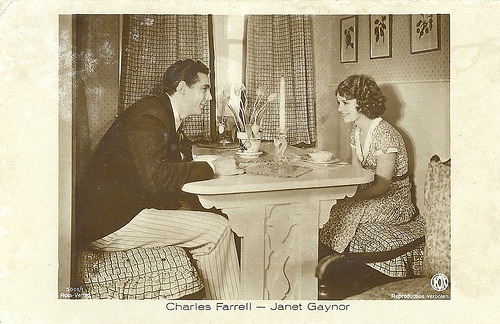
German postcard by Ross Verlag, no. 5001/1, 1930-1931. Photo: Fox. Janet Gaynor and Charles Farrell in the early sound film Sunnyside Up (David Butler, 1929).
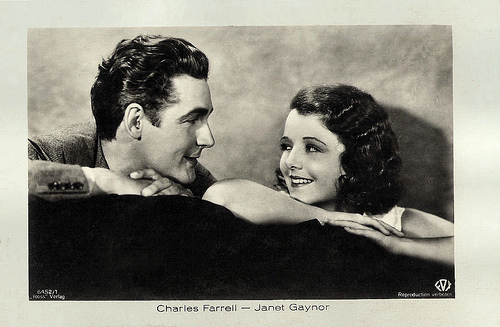
German postcard by Ross Verlag, no. 6452/1, 1931-1932. Photo: Fox. Publicity still for Delicious (David Butler, 1931), with Charles Farrell.
Taxi Cab Accident
In the 1950s, Janet Gaynor returned to acting. She appeared in the Pat Boone musical Bernardine (Henry Levin, 1957) as Boone’s mother, and in 1959, she made her stage debut in The Midnight Sun, but the production was a disaster.
Twenty years later she was offered a starring role in the Broadway production of Harold and Maude, the story of an 80-year-old woman who has a relationship with an 18-year-old boy. Reviewers liked Gaynor but not the play. It closed after 21 performances.
But Gaynor continued to appear occasionally on the stage. Her last screen appearance was a guest-role in the popular TV series The Love Boat (1981). In 1982 she starred in a touring production of On Golden Pond.
That same year, Gaynor and her longtime close friend Mary Martin were in a taxi cab accident in San Francisco. Martin's manager was killed and Gaynor suffered 11 rib fractures and pelvic and abdominal injuries. She never fully recovered from her injuries and two years later, she died of complications from the accident, at Desert Hospital in Palm Springs, Calif. Janet Gaynor was 77.
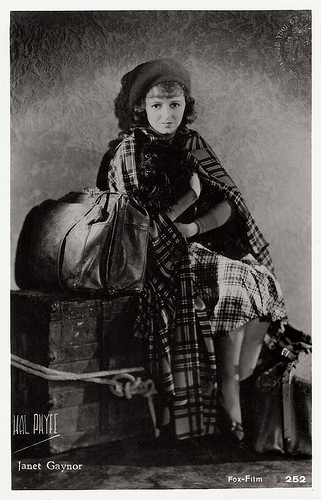
Dutch postcard, no 252. Photo: Hal Phyfe / Fox. Publcity still for Delicious (David Butler, 1931).
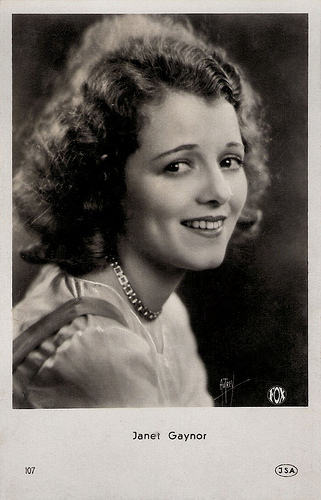
Dutch postcard by J.S.A., no 107. Photo: Max Munn Autrey / Fox.
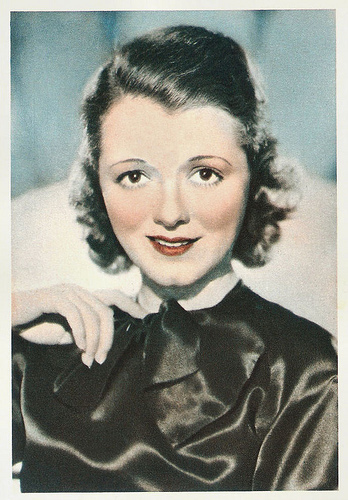
British postcard by De Reszke Cigarettes, no. 45.
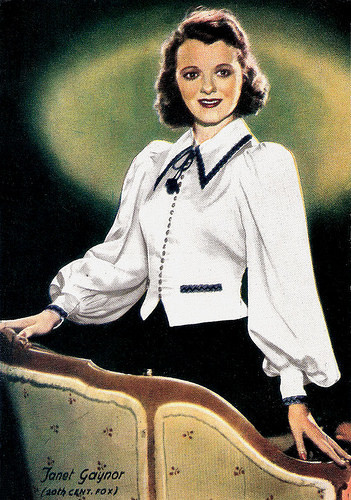
Italian postcard by TET (Tip. Ed. Taurinia, Torino). Photo: 20th Century Fox.
Sources: David Bird (The New York Times), (IMDb), TCM, Wikipedia, and .

Austrian postcard by Iris Verlag, no. 5491. Photo: Fox.

Austrian postcard by Iris Verlag, no. 5702. Photo: Charles Munn Autrey / Fox-Film.

German postcard by Ross Verlag, no. 1852/2, 1927-1928. Photo: Fox. Janet Gaynor as Dutch farmer girl, 'Volendammer' style.

German postcard by Ross Verlag no. 4403/2, 1929-1930. Photo: Fox. Publicity still for Christina (William K. Howard, 1929).
Murnau
Janet Gaynor was born Laura Gainor in 1906, in Philadelphia. Her family moved to Chicago and to Hollywood, where her stepfather was determined that she become a star. She made the rounds of the studios and eventually found work as an extra.
She got her start in films through her sister, a secretary for producer Hal Roach. Gaynor later boasted that she "never had an acting lesson in my life". Universal gave her a contract and she appeared in such shorts as The Gunless Bad Man (William Wyler, 1926) and Don't Shoot (William Wyler, 1926).
Fox executives noticed her and called her in for a test for the second lead in The Johnstown Flood (Irving Cummings, 1926) with George O’ Brien. After the test, the 18-years-old was signed to a five-year contract. She worked with John Ford on The Shamrock Handicap (1926) and The Blue Eagle (1926), again opposite George O’Brien.
Seventh Heaven (Frank Borzage, 1927), in which she played Diane, a Montmartre waif who is rescued from hardship and cruelty by Charles Farrell, made her a star. In 1928 the Oscars were first presented, and Gaynor was named best actress. The award was for her roles in three films - Seventh Heaven (1927), Sunrise (F. W. Murnau, 1927), and Street Angel (Frank Borzage, 1928). This was the first and only time an actress won the Oscar for multiple roles.
Gaynor again worked with Friedrich Wilhelm Murnau on the circus drama 4 Devils (F.W. Murnau, 1928) and with Farrell and Borzage on Lucky Star (Frank Borzage, 1929). She was teamed with Charles Farrell in 11 films altogether as she went from "the World's Sweetheart" to "America's favorite love-birds".

Italian postcard by G.B. Falci Editore, Milano, no. 708. Photo: Charles Munn Autrey / Fox. Publcity still for 4 Devils (Friedrich Wilhelm Murnau, 1928). 4 Devils is one of the most famous 'lost' films.

Italian postcard by G.B. Falci Editore, Milano, no. 711. Photo: Charles Munn Autrey / Fox. Publcity still for 4 Devils (Friedrich Wilhelm Murnau, 1928), with Charles Morton, Janet Gaynor, Nancy Drexel and Barry Norton.

Italian postcard by G.B. Falci Editore, Milano, no. 720. Photo: Charles Munn Autrey / Fox. Publcity still for 4 Devils (Friedrich Wilhelm Murnau, 1928), with Charles Morton
A Star Is Born
Janet Gaynor switched easily to the new talking pictures as her voice translated well to sound. In 12 successive years she made 36 films for Fox, including Daddy Longlegs (Alfred Santell, 1931), Tess of the Storm Country (Alfred Santell, 1932), State Fair (Henry King, 1933), and The Farmer Takes a Wife (Victor Fleming, 1935).
But Gaynor eventually tired of being typecast in the endless comedies and musicals that exploited her special qualities of innocence, vulnerability and sweetness. In 1937, she left Fox to join David O. Selznick and make A Star Is Born (William A. Wellman, 1938) with Fredric March in the classic story of two married film stars, one on the way up and the other on the way down. It was to be one of her most memorable films, and she was nominated for another Academy Award.
Denny Jackson at IMDb : “She was very convincing as Vicki Lester (aka Esther Blodgett), struggling actress trying for the big time. Told by the receptionist at Central casting ‘You know what your chances are? One in a hundred thousand,’ Esther/Vicki replies, ‘But maybe--I'm that one’”
Gaynor was very quiet about her personal life and valued her privacy. In 1932, she had married lawyer Lydell Peck, but they were divorced in 1934. After appearing in The Young in Heart (1938), Gaynor announced that she was retiring from acting. She was 33 and at the peak of her career.
In 1939, she married famous MGM costume designer Gilbert Adrian, known by the single name Adrian. The following year, they had a son, Robin Gaynor Adrian. Her husband died in 1959, and she married producer Paul Gregory in 1964. After she left full-time acting, Gaynor spent much of her time painting; she had several one-woman shows of her work at galleries in Palm Springs, Chicago and New York. Mostly she painted plants and flowers.

Italian postcard offered by Cioccolata Lurati, no. 124. Photo: Fox. Publicity still for Seventh Heaven (Frank Borzage, 1927) with Charles Farrell.

Italian postcard. Imprint on back: Ballerini & Fratini, Florence, no. 125, but originally an Iris Verlag card, no. 5934. Photo: Charles Munn Autrey / Fox.

German postcard by Ross Verlag, no. 5001/1, 1930-1931. Photo: Fox. Janet Gaynor and Charles Farrell in the early sound film Sunnyside Up (David Butler, 1929).

German postcard by Ross Verlag, no. 6452/1, 1931-1932. Photo: Fox. Publicity still for Delicious (David Butler, 1931), with Charles Farrell.
Taxi Cab Accident
In the 1950s, Janet Gaynor returned to acting. She appeared in the Pat Boone musical Bernardine (Henry Levin, 1957) as Boone’s mother, and in 1959, she made her stage debut in The Midnight Sun, but the production was a disaster.
Twenty years later she was offered a starring role in the Broadway production of Harold and Maude, the story of an 80-year-old woman who has a relationship with an 18-year-old boy. Reviewers liked Gaynor but not the play. It closed after 21 performances.
But Gaynor continued to appear occasionally on the stage. Her last screen appearance was a guest-role in the popular TV series The Love Boat (1981). In 1982 she starred in a touring production of On Golden Pond.
That same year, Gaynor and her longtime close friend Mary Martin were in a taxi cab accident in San Francisco. Martin's manager was killed and Gaynor suffered 11 rib fractures and pelvic and abdominal injuries. She never fully recovered from her injuries and two years later, she died of complications from the accident, at Desert Hospital in Palm Springs, Calif. Janet Gaynor was 77.

Dutch postcard, no 252. Photo: Hal Phyfe / Fox. Publcity still for Delicious (David Butler, 1931).

Dutch postcard by J.S.A., no 107. Photo: Max Munn Autrey / Fox.

British postcard by De Reszke Cigarettes, no. 45.

Italian postcard by TET (Tip. Ed. Taurinia, Torino). Photo: 20th Century Fox.
Sources: David Bird (The New York Times), (IMDb), TCM, Wikipedia, and .
Published on April 15, 2017 22:00
April 14, 2017
Julie Delpy
French actress Julie Delpy (1969) made her first film appearance at 14 in Détective (1985) by Jean-Luc Godard. Since then, she starred in many European films by directors as Bertrand Tavernier, Agnieszka Holland and Krzysztof Kieslowski and such Hollywood movies as the cult hit Before Sunrise (1995). Later she started to write and direct her own films.
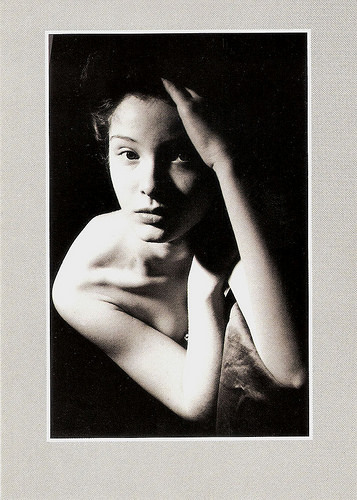
French postcard in the Le jour se lève series by Editions Humour à la carte, Paris, no. ST-167. Photo: Jean-Pierre Larcher.
Three Colours
Julie Delpy was born in Paris, France, in 1969 to Albert Delpy, a theatre director, and Marie Pillet, an actress in feature films and the avant-garde theater. Julie was an only child. Growing up in Paris, France, she was exposed to the arts and made her first short film at age 12, and wrote her first screenplay at 16.
Two years later, she made her film debut in Jean-Luc Godard's Détective (1985). She was excellent next to Michel Piccoli and Juliette Binoche in Mauvais Sang/Bad Blood (1986), director Leos Carax's second film. The film played at the 37th Berlin International Film Festival before being nominated for 3 César Awards (including one for Delpy) and winning the Prix Louis-Delluc.
Delpy then starred in the title role in Bertrand Tavernier's La Passion Béatrice (1987). For her performance, she was nominated for a César Award for Most Promising Actress. She used the money she earned to pay for her first trip to New York City. She also appeared in King Lear (Jean-Luc Godard, 1987), a sardonic parody and adaptation of William Shakespeare's play, and in the Spanish drama La noche oscura/The Dark Night (Carlos Saura, 1989) in which she appeared as the Virgin Mary.
Delpy became an international celebrity after starring in Europa Europa (1990) directed by Agnieszka Holland. In the film, she plays a young pro-Nazi who falls in love with the hero, Solomon Perel (Marco Hofschneider), not knowing that he is Jewish.
From 1990 till 1995, she studied filmmaking at New York University's Tisch School of the Arts. She saved the money she earned with acting jobs to help pay her studies. She played leads in Voyager (Volker Schlöndorf, 1991) with Sam Shepard, and Warszawa. Année 5703/Warsaw. Year 5703 (Przemyslaw Skwirczynski, 1992) with Lambert Wilson and Hanna Schygulla .
Polish director Krzysztof Kieslowski became a mentor to her in 1993, and he cast her in his Trois couleurs: Blanc (1994), the second film of his Three Colors Trilogy. Delpy also appeared briefly in the other two films in the same role. She also starred in several American productions, including Disney’s The Three Musketeers (Stephen Herek, 1993), and Killing Zoe (Roger Avary, 1993), opposite Eric Stoltz. She wrote and directed the short film Blah Blah Blah (1995), which screened at the Sundance Film Festival.
Trailer Europa Europa (1990). Source: Movieclips Trailer Vault (YouTube).
Trailer Trois couleurs: Blanc (1994). Source: Danios12345 (YouTube).
Before
Julie Delpy is best known for Richard Linklater's ‘Before’ series, alongside Ethan Hawke. The series started in 1995 with Before Sunrise, for which she wrote much of her own dialogue. The film received glowing reviews and was considered one of the most significant films of the 1990s' independent film movement.
The success of Before Sunrise led to the casting of Delpy in the American horror comedy An American Werewolf in Paris (Anthony Waller, 1997). Delpy reprised her Before Sunrise character, Céline, in the sequels Before Sunset (2004), and Before Midnight (2013). Both were also well received and Before Sunset earned Delpy, who co-wrote the script, her first Academy Award nomination for Writing Adapted Screenplay.
In 2001, she became a United States citizen, but she still keeps her French citizenship. She made her feature length directorial debut with Looking for Jimmy (2002) which she also wrote and produced. Delpy is also a musical artist. She released a self-titled album, Julie Delpy in 2003.
Delpy directed, wrote, edited, and co-produced the original score for 2 Days in Paris (2007), co-starring Adam Goldberg. The film also features Delpy's real-life parents, Marie Pillet and Albert Delpy, as her character's parents. In 2012 she released 2 Days in New York, a sequel to 2 Days in Paris. The film starred Delpy and actor Chris Rock.
Her son Leo was born in 2009. Father is her boyfriend Marc Streitenfeld. Julie Delpy is a resident of Los Angeles. She has been nominated for three César Awards, and two Academy Awards.
Trailer Before Sunrise (1995). Source: pamfilyam (YouTube).
Trailer 2 Days in Paris (2007). Source: Movieclips Trailers (YouTube).
Sources: (IMDb), Wikipedia, and .

French postcard in the Le jour se lève series by Editions Humour à la carte, Paris, no. ST-167. Photo: Jean-Pierre Larcher.
Three Colours
Julie Delpy was born in Paris, France, in 1969 to Albert Delpy, a theatre director, and Marie Pillet, an actress in feature films and the avant-garde theater. Julie was an only child. Growing up in Paris, France, she was exposed to the arts and made her first short film at age 12, and wrote her first screenplay at 16.
Two years later, she made her film debut in Jean-Luc Godard's Détective (1985). She was excellent next to Michel Piccoli and Juliette Binoche in Mauvais Sang/Bad Blood (1986), director Leos Carax's second film. The film played at the 37th Berlin International Film Festival before being nominated for 3 César Awards (including one for Delpy) and winning the Prix Louis-Delluc.
Delpy then starred in the title role in Bertrand Tavernier's La Passion Béatrice (1987). For her performance, she was nominated for a César Award for Most Promising Actress. She used the money she earned to pay for her first trip to New York City. She also appeared in King Lear (Jean-Luc Godard, 1987), a sardonic parody and adaptation of William Shakespeare's play, and in the Spanish drama La noche oscura/The Dark Night (Carlos Saura, 1989) in which she appeared as the Virgin Mary.
Delpy became an international celebrity after starring in Europa Europa (1990) directed by Agnieszka Holland. In the film, she plays a young pro-Nazi who falls in love with the hero, Solomon Perel (Marco Hofschneider), not knowing that he is Jewish.
From 1990 till 1995, she studied filmmaking at New York University's Tisch School of the Arts. She saved the money she earned with acting jobs to help pay her studies. She played leads in Voyager (Volker Schlöndorf, 1991) with Sam Shepard, and Warszawa. Année 5703/Warsaw. Year 5703 (Przemyslaw Skwirczynski, 1992) with Lambert Wilson and Hanna Schygulla .
Polish director Krzysztof Kieslowski became a mentor to her in 1993, and he cast her in his Trois couleurs: Blanc (1994), the second film of his Three Colors Trilogy. Delpy also appeared briefly in the other two films in the same role. She also starred in several American productions, including Disney’s The Three Musketeers (Stephen Herek, 1993), and Killing Zoe (Roger Avary, 1993), opposite Eric Stoltz. She wrote and directed the short film Blah Blah Blah (1995), which screened at the Sundance Film Festival.
Trailer Europa Europa (1990). Source: Movieclips Trailer Vault (YouTube).
Trailer Trois couleurs: Blanc (1994). Source: Danios12345 (YouTube).
Before
Julie Delpy is best known for Richard Linklater's ‘Before’ series, alongside Ethan Hawke. The series started in 1995 with Before Sunrise, for which she wrote much of her own dialogue. The film received glowing reviews and was considered one of the most significant films of the 1990s' independent film movement.
The success of Before Sunrise led to the casting of Delpy in the American horror comedy An American Werewolf in Paris (Anthony Waller, 1997). Delpy reprised her Before Sunrise character, Céline, in the sequels Before Sunset (2004), and Before Midnight (2013). Both were also well received and Before Sunset earned Delpy, who co-wrote the script, her first Academy Award nomination for Writing Adapted Screenplay.
In 2001, she became a United States citizen, but she still keeps her French citizenship. She made her feature length directorial debut with Looking for Jimmy (2002) which she also wrote and produced. Delpy is also a musical artist. She released a self-titled album, Julie Delpy in 2003.
Delpy directed, wrote, edited, and co-produced the original score for 2 Days in Paris (2007), co-starring Adam Goldberg. The film also features Delpy's real-life parents, Marie Pillet and Albert Delpy, as her character's parents. In 2012 she released 2 Days in New York, a sequel to 2 Days in Paris. The film starred Delpy and actor Chris Rock.
Her son Leo was born in 2009. Father is her boyfriend Marc Streitenfeld. Julie Delpy is a resident of Los Angeles. She has been nominated for three César Awards, and two Academy Awards.
Trailer Before Sunrise (1995). Source: pamfilyam (YouTube).
Trailer 2 Days in Paris (2007). Source: Movieclips Trailers (YouTube).
Sources: (IMDb), Wikipedia, and .
Published on April 14, 2017 22:00
Paul van Yperen's Blog
- Paul van Yperen's profile
- 13 followers
Paul van Yperen isn't a Goodreads Author
(yet),
but they
do have a blog,
so here are some recent posts imported from
their feed.



